Samsung Electronics Co SMP907A Portable Tablet with Multi-Band WCDMA/LTE, WLAN, Bluetooth and ANT+ User Manual P905V
Samsung Electronics Co Ltd Portable Tablet with Multi-Band WCDMA/LTE, WLAN, Bluetooth and ANT+ P905V
Contents
- 1. Users Manual 1
- 2. Users Manual 2
Users Manual 1

DRAFT For Internal Use Only
SM-P907A
A N D R O I D T A B L E T
User Manual
Please read this manual before operating your
device and keep it for future reference.

Warning!
This product contains chemicals known to the State of California to cause cancer and reproductive toxicity.
Intellectual Property
All Intellectual Property, as defined below, owned by or which is otherwise the property of Samsung or its respective suppliers
relating to the SAMSUNG Phone, including but not limited to, accessories, parts, or software relating there to (the “Phone
System”), is proprietary to Samsung and protected under federal laws, state laws, and international treaty provisions. Intellectual
Property includes, but is not limited to, inventions (patentable or unpatentable), patents, trade secrets, copyrights, software,
computer programs, and related documentation and other works of authorship. You may not infringe or otherwise violate the
rights secured by the Intellectual Property. Moreover, you agree that you will not (and will not attempt to) modify, prepare
derivative works of, reverse engineer, decompile, disassemble, or otherwise attempt to create source code from the software. No
title to or ownership in the Intellectual Property is transferred to you. All applicable rights of the Intellectual Property shall remain
with SAMSUNG and its suppliers.
Open Source Software
Some software components of this product, including but not limited to 'PowerTOP' and 'e2fsprogs', incorporate source code
covered under GNU General Public License (GPL), GNU Lesser General Public License (LGPL), OpenSSL License, BSD License and
other open source licenses. To obtain the source code covered under the open source licenses, please visit:
http://opensource.samsung.com
.
Disclaimer of Warranties; Exclusion of Liability
EXCEPT AS SET FORTH IN THE EXPRESS WARRANTY CONTAINED ON THE WARRANTY PAGE ENCLOSED WITH THE PRODUCT, THE
PURCHASER TAKES THE PRODUCT "AS IS", AND SAMSUNG MAKES NO EXPRESS OR IMPLIED WARRANTY OF ANY KIND
WHATSOEVER WITH RESPECT TO THE PRODUCT, INCLUDING BUT NOT LIMITED TO THE MERCHANTABILITY OF THE PRODUCT OR
DRAFT For Internal Use Only
ITS FITNESS FOR ANY PARTICULAR PURPOSE OR USE; THE DESIGN, CONDITION OR QUALITY OF THE PRODUCT; THE
PERFORMANCE OF THE PRODUCT; THE WORKMANSHIP OF THE PRODUCT OR THE COMPONENTS CONTAINED THEREIN; OR
COMPLIANCE OF THE PRODUCT WITH THE REQUIREMENTS OF ANY LAW, RULE, SPECIFICATION OR CONTRACT PERTAINING
THERETO. NOTHING CONTAINED IN THE INSTRUCTION MANUAL SHALL BE CONSTRUED TO CREATE AN EXPRESS OR IMPLIED
WARRANTY OF ANY KIND WHATSOEVER WITH RESPECT TO THE PRODUCT. IN ADDITION, SAMSUNG SHALL NOT BE LIABLE FOR
ANY DAMAGES OF ANY KIND RESULTING FROM THE PURCHASE OR USE OF THE PRODUCT OR ARISING FROM THE BREACH OF
THE EXPRESS WARRANTY, INCLUDING INCIDENTAL, SPECIAL OR CONSEQUENTIAL DAMAGES, OR LOSS OF ANTICIPATED PROFITS
OR BENEFITS.
Modification of Software
SAMSUNG IS NOT LIABLE FOR PERFORMANCE ISSUES OR INCOMPATIBILITIES CAUSED BY YOUR EDITING OF REGISTRY SETTINGS,
OR YOUR MODIFICATION OF OPERATING SYSTEM SOFTWARE.
USING CUSTOM OPERATING SYSTEM SOFTWARE MAY CAUSE YOUR DEVICE AND APPLICATIONS TO WORK IMPROPERLY. YOUR
CARRIER MAY NOT PERMIT USERS TO DOWNLOAD CERTAIN SOFTWARE, SUCH AS CUSTOM OS.
IF YOUR CARRIER PROHIBITS THIS, IF YOU ATTEMPT TO DOWNLOAD SOFTWARE ONTO THE DEVICE WITHOUT AUTHORIZATION,
YOU WILL BE NOTIFIED ON THE SCREEN THAT THE PHONE WILL NO LONGER OPERATE AND BE INSTRUCTED TO POWER DOWN
THE DEVICE. YOU MUST THEN CONTACT YOUR CARRIER TO RESTORE THE DEVICE TO THE CARRIER AUTHORIZED SETTINGS.
SAFE™ (Samsung Approved For Enterprise)
SAFE™: "SAFE™" (Samsung for Enterprise) is a mark for a Samsung device which has been tested against Samsung's own
internal criteria for interoperability with certain third party security-related solutions for MDM and VPN. The testing includes field
testing with local network connection and menu tree testing which tests functionality of the solutions in conjunction with the
Samsung device. During the testing, the device is tested with the security solutions to see if the solutions work with the device as
described by the third party security solution providers. The testing, for example, includes field testing with local network
DRAFT For Internal Use Only

connection and menu tree testing which tests functionality of the solutions in conjunction with the Samsung device. For more
information about Samsung's SAFE™ program, please refer to
www.samsung.com/us/safe
.
Disclaimer of Warranties: EXCEPT AS OTHERWISE PROVIDED IN THEIR STANDARD END USER LICENSE AND WARRANTY, TO THE
FULL EXTENT PERMITTED BY LAW SAMSUNG ELECTRONICS CO., LTD., SAMSUNG TELECOMMUNICATIONS AMERICA, LLC, AND
THEIR AFFILIATES (COLLECTIVELY REFERRED TO HEREIN AS THE "SAMSUNG ENTITIES") EXPRESSLY DISCLAIM ANY AND ALL
WARRANTIES, EXPRESS OR IMPLIED, INCLUDING ANY WARRANTY OF MERCHANTABILITY, FITNESS FOR A PARTICULAR PURPOSE,
INTEROPERABILITY OR NON-INFRINGEMENT, WITH RESPECT TO INFORMATION TECHNOLOGY SECURITY PROTECTION, SAFE™
DEVICES AND APPLICATIONS TESTED WITH SAFE™ DEVICES. IN NO EVENT SHALL THE SAMSUNG ENTITIES BE LIABLE FOR ANY
DIRECT, INDIRECT, INCIDENTAL, PUNITIVE, OR CONSEQUENTIAL DAMAGES OF ANY KIND WHATSOEVER WITH RESPECT TO
INFORMATION TECHNOLOGY SECURITY PROTECTION, SAFE™ DEVICES OR APPLICATIONS TESTED WITH SAFE™ DEVICES. In
addition, information technology security protection will be affected by features or functionality associated with, among other
things the e-mail platform, master data management, and virtual private network solutions selected by the software provider,
solution provider or user. Choice of an e-mail, master data management, and virtual private network solution is at the sole
discretion of the software provider, solution provider or user and any associated effect on information technology security
protection is solely the responsibility of the software provider, solution provider or user. For complete statement of limited
warranty, please refer to
www.samsung.com/us/safe
, available on the web and where Samsung smartphone and Galaxy Tab™
devices are sold. [101212]
Samsung Telecommunications America (STA), LLC
Headquarters:
1301 E. Lookout Drive
Richardson, TX 75082
DRAFT For Internal Use Only

©2013 Samsung Electronics America, Inc. All rights reserved.
Do you have questions about your Samsung Mobile Device?
For 24 hour information and assistance, we offer a new FAQ/ARS System (Automated Response System) at:
www.samsung.com/us/support
Nuance®, VSuite™, T9® Text Input, XT9® Smart Input, and the Nuance logo are trademarks or registered trademarks of Nuance
Communications, Inc., or its affiliates in the United States and/or other countries.
The Bluetooth® word mark, figure mark (stylized “B Design”), and combination mark (Bluetooth word mark and “B Design”) are
registered trademarks and are wholly owned by the Bluetooth SIG.
microSDTM, microSDHCTM, and the microSD logo are Trademarks of the SD Card Association.
Customer Care Center:
1000 Klein Rd.
Plano, TX 75074
Toll Free Tel: 1.888.987.HELP (4357)
Internet Address:
http://www.samsung.com
DRAFT For Internal Use Only
Google, the Google logo, Android, the Android logo, Gmail, Google Hangouts, Google Maps, Google Play, Google Play Books,
Google Play Magazines, Google Play Movies & TV, Google Play Music, Picasa, and YouTube and other marks are trademarks of
Google Inc.
Wi-Fi is a registered trademark of the Wireless Fidelity Alliance, Inc.
Peel and the Peel logo are marks owned by Peel Technologies, Inc. and may be registered.
Polaris Office and the Polaris Office logo are marks owned by Infraware and may be trademarks or registered trademarks.
DRAFT For Internal Use Only

1
Table of Contents
Section 1: Getting Started .......................... 6
Understanding This User Manual . . . . . . . . . . . 6
Battery . . . . . . . . . . . . . . . . . . . . . . . . . . . . . . . 7
Turning Your Device On and Off . . . . . . . . . . . . 9
Setting Up Your Device . . . . . . . . . . . . . . . . . . . 9
Task Manager . . . . . . . . . . . . . . . . . . . . . . . . 11
Memory Card . . . . . . . . . . . . . . . . . . . . . . . . . 12
Securing Your Device . . . . . . . . . . . . . . . . . . . 14
Section 2: Understanding Your Device .... 15
Features . . . . . . . . . . . . . . . . . . . . . . . . . . . . 15
Front and Sides . . . . . . . . . . . . . . . . . . . . . . . 16
Home Screen . . . . . . . . . . . . . . . . . . . . . . . . . 18
Navigating Your Device . . . . . . . . . . . . . . . . . 21
Using the Touch Screen . . . . . . . . . . . . . . . . . 22
S Pen . . . . . . . . . . . . . . . . . . . . . . . . . . . . . . . 28
Samsung Smart Pause . . . . . . . . . . . . . . . . . . 32
Samsung Smart Scroll . . . . . . . . . . . . . . . . . . 33
Activating Multi Window . . . . . . . . . . . . . . . . . 33
Notifications . . . . . . . . . . . . . . . . . . . . . . . . . . 35
Notifications Panel . . . . . . . . . . . . . . . . . . . . . 36
Indicator Icons . . . . . . . . . . . . . . . . . . . . . . . . 37
Primary Shortcuts . . . . . . . . . . . . . . . . . . . . . 38
Other App Shortcuts . . . . . . . . . . . . . . . . . . . . 38
Widgets . . . . . . . . . . . . . . . . . . . . . . . . . . . . . 39
App Shortcuts . . . . . . . . . . . . . . . . . . . . . . . . 39
Folders . . . . . . . . . . . . . . . . . . . . . . . . . . . . . . 40
Wallpapers . . . . . . . . . . . . . . . . . . . . . . . . . . . 41
Apps Screen . . . . . . . . . . . . . . . . . . . . . . . . . . 42
Entering Text . . . . . . . . . . . . . . . . . . . . . . . . . 42
Section 3: Accounts and Contacts ...........46
Accounts . . . . . . . . . . . . . . . . . . . . . . . . . . . . 46
Your Google Account . . . . . . . . . . . . . . . . . . . 47
Your Samsung Account . . . . . . . . . . . . . . . . . 47
Contacts . . . . . . . . . . . . . . . . . . . . . . . . . . . . . 47
Groups . . . . . . . . . . . . . . . . . . . . . . . . . . . . . . 51
Favorites . . . . . . . . . . . . . . . . . . . . . . . . . . . . 53
Section 4: Messaging ................................54
Types of Messages . . . . . . . . . . . . . . . . . . . . 54
DRAFT For Internal Use Only
2
Gmail . . . . . . . . . . . . . . . . . . . . . . . . . . . . . . . 54
Email . . . . . . . . . . . . . . . . . . . . . . . . . . . . . . . . 55
Hangouts . . . . . . . . . . . . . . . . . . . . . . . . . . . . . 58
Google+ . . . . . . . . . . . . . . . . . . . . . . . . . . . . . 58
Messenger . . . . . . . . . . . . . . . . . . . . . . . . . . . 58
ChatON . . . . . . . . . . . . . . . . . . . . . . . . . . . . . . 58
Section 5: Music ........................................60
Listening to Music . . . . . . . . . . . . . . . . . . . . . . 60
Play Music . . . . . . . . . . . . . . . . . . . . . . . . . . . 60
Music Player . . . . . . . . . . . . . . . . . . . . . . . . . . 60
Section 6: Camera and Video ...................66
Camera . . . . . . . . . . . . . . . . . . . . . . . . . . . . . . 66
Zooming In and Out . . . . . . . . . . . . . . . . . . . . . 70
Gallery . . . . . . . . . . . . . . . . . . . . . . . . . . . . . . . 74
Story Album . . . . . . . . . . . . . . . . . . . . . . . . . . 78
Video . . . . . . . . . . . . . . . . . . . . . . . . . . . . . . . . 80
YouTube . . . . . . . . . . . . . . . . . . . . . . . . . . . . . 82
Section 7: Connections .............................83
Wi-Fi . . . . . . . . . . . . . . . . . . . . . . . . . . . . . . . . 83
Wi-Fi Direct . . . . . . . . . . . . . . . . . . . . . . . . . . . 86
Bluetooth . . . . . . . . . . . . . . . . . . . . . . . . . . . . 87
Kies Via Wi-Fi . . . . . . . . . . . . . . . . . . . . . . . . . 89
Synchronizing with Windows Media Player . . .89
Connecting as a Mass Storage Device . . . . . . .90
Section 8: Applications .............................91
Accessing Applications . . . . . . . . . . . . . . . . . .91
Action Memo . . . . . . . . . . . . . . . . . . . . . . . . . .92
Alarm . . . . . . . . . . . . . . . . . . . . . . . . . . . . . . .92
Bloomberg Businessweek+ . . . . . . . . . . . . . . .93
Calculator . . . . . . . . . . . . . . . . . . . . . . . . . . . .93
Calendar . . . . . . . . . . . . . . . . . . . . . . . . . . . . .94
Camera . . . . . . . . . . . . . . . . . . . . . . . . . . . . . .95
ChatON . . . . . . . . . . . . . . . . . . . . . . . . . . . . . .96
Chrome . . . . . . . . . . . . . . . . . . . . . . . . . . . . . .96
Contacts . . . . . . . . . . . . . . . . . . . . . . . . . . . . .96
Downloads . . . . . . . . . . . . . . . . . . . . . . . . . . .96
Dropbox . . . . . . . . . . . . . . . . . . . . . . . . . . . . . .96
Email . . . . . . . . . . . . . . . . . . . . . . . . . . . . . . . .97
Evernote . . . . . . . . . . . . . . . . . . . . . . . . . . . . .97
Flipboard . . . . . . . . . . . . . . . . . . . . . . . . . . . . .97
Gallery . . . . . . . . . . . . . . . . . . . . . . . . . . . . . . .97
Gmail . . . . . . . . . . . . . . . . . . . . . . . . . . . . . . . .97
Google Search . . . . . . . . . . . . . . . . . . . . . . . . .97
Google Settings . . . . . . . . . . . . . . . . . . . . . . . .99
DRAFT For Internal Use Only
3
Google+ . . . . . . . . . . . . . . . . . . . . . . . . . . . . . 99
Group Play . . . . . . . . . . . . . . . . . . . . . . . . . . . 99
Hangouts . . . . . . . . . . . . . . . . . . . . . . . . . . . 101
Help . . . . . . . . . . . . . . . . . . . . . . . . . . . . . . . 101
Internet . . . . . . . . . . . . . . . . . . . . . . . . . . . . 101
KNOX . . . . . . . . . . . . . . . . . . . . . . . . . . . . . . 101
Maps . . . . . . . . . . . . . . . . . . . . . . . . . . . . . . 101
Messenger . . . . . . . . . . . . . . . . . . . . . . . . . . 101
Music . . . . . . . . . . . . . . . . . . . . . . . . . . . . . . 101
My Files . . . . . . . . . . . . . . . . . . . . . . . . . . . . 102
NYTimes . . . . . . . . . . . . . . . . . . . . . . . . . . . 102
Play Books . . . . . . . . . . . . . . . . . . . . . . . . . . 102
Play Games . . . . . . . . . . . . . . . . . . . . . . . . . 102
Play Magazines . . . . . . . . . . . . . . . . . . . . . . 102
Play Movies & TV . . . . . . . . . . . . . . . . . . . . . 102
Play Music . . . . . . . . . . . . . . . . . . . . . . . . . . 102
Play Store . . . . . . . . . . . . . . . . . . . . . . . . . . 103
Polaris Office 5 . . . . . . . . . . . . . . . . . . . . . . 104
S Finder . . . . . . . . . . . . . . . . . . . . . . . . . . . . 105
S Note . . . . . . . . . . . . . . . . . . . . . . . . . . . . . 105
S Translator . . . . . . . . . . . . . . . . . . . . . . . . . 109
S Voice . . . . . . . . . . . . . . . . . . . . . . . . . . . . 110
Samsung Apps . . . . . . . . . . . . . . . . . . . . . . . 111
Samsung Hub . . . . . . . . . . . . . . . . . . . . . . . 111
Samsung Link . . . . . . . . . . . . . . . . . . . . . . . 111
Scrapbook . . . . . . . . . . . . . . . . . . . . . . . . . . 112
Screen Saver . . . . . . . . . . . . . . . . . . . . . . . . 112
Settings . . . . . . . . . . . . . . . . . . . . . . . . . . . . 113
SketchBook for Galaxy . . . . . . . . . . . . . . . . . 113
Story Album . . . . . . . . . . . . . . . . . . . . . . . . . 114
TripAdvisor . . . . . . . . . . . . . . . . . . . . . . . . . . 114
Twitter . . . . . . . . . . . . . . . . . . . . . . . . . . . . . 114
Video . . . . . . . . . . . . . . . . . . . . . . . . . . . . . . 114
Video Editor . . . . . . . . . . . . . . . . . . . . . . . . . 114
Voice Search . . . . . . . . . . . . . . . . . . . . . . . . 114
WatchON . . . . . . . . . . . . . . . . . . . . . . . . . . . 114
World Clock . . . . . . . . . . . . . . . . . . . . . . . . . 115
YouTube . . . . . . . . . . . . . . . . . . . . . . . . . . . . 115
Section 9: Settings ..................................116
About Settings . . . . . . . . . . . . . . . . . . . . . . . 116
Settings Tabs . . . . . . . . . . . . . . . . . . . . . . . . 116
Connections . . . . . . . . . . . . . . . . . . . . . . . . . 116
Wi-Fi . . . . . . . . . . . . . . . . . . . . . . . . . . . . . . 116
Wi-Fi Direct Settings . . . . . . . . . . . . . . . . . . 116
DRAFT For Internal Use Only
4
Bluetooth . . . . . . . . . . . . . . . . . . . . . . . . . . . 116
Airplane Mode . . . . . . . . . . . . . . . . . . . . . . . . 117
Data Usage . . . . . . . . . . . . . . . . . . . . . . . . . . 117
Location Services . . . . . . . . . . . . . . . . . . . . . 118
More Networks . . . . . . . . . . . . . . . . . . . . . . . 118
Nearby Devices . . . . . . . . . . . . . . . . . . . . . . . 120
Screen Mirroring . . . . . . . . . . . . . . . . . . . . . . 120
Device . . . . . . . . . . . . . . . . . . . . . . . . . . . . . . 121
Sound . . . . . . . . . . . . . . . . . . . . . . . . . . . . . . 121
Display . . . . . . . . . . . . . . . . . . . . . . . . . . . . . 123
Multi Window . . . . . . . . . . . . . . . . . . . . . . . . 123
Lock Screen . . . . . . . . . . . . . . . . . . . . . . . . . 124
Wallpaper . . . . . . . . . . . . . . . . . . . . . . . . . . . 125
Font . . . . . . . . . . . . . . . . . . . . . . . . . . . . . . . 126
Notification Panel . . . . . . . . . . . . . . . . . . . . . 126
Accessibility . . . . . . . . . . . . . . . . . . . . . . . . . 126
Blocking Mode . . . . . . . . . . . . . . . . . . . . . . . 129
Controls . . . . . . . . . . . . . . . . . . . . . . . . . . . . 129
Language and Input . . . . . . . . . . . . . . . . . . . . 129
Voice Control . . . . . . . . . . . . . . . . . . . . . . . . . 133
S Pen . . . . . . . . . . . . . . . . . . . . . . . . . . . . . . 133
Motions . . . . . . . . . . . . . . . . . . . . . . . . . . . . . 134
Palm Motion . . . . . . . . . . . . . . . . . . . . . . . . .134
Smart Screen . . . . . . . . . . . . . . . . . . . . . . . .135
General . . . . . . . . . . . . . . . . . . . . . . . . . . . . .136
Accounts . . . . . . . . . . . . . . . . . . . . . . . . . . . .136
Cloud . . . . . . . . . . . . . . . . . . . . . . . . . . . . . . .138
Backup and Reset . . . . . . . . . . . . . . . . . . . . .139
Date and Time . . . . . . . . . . . . . . . . . . . . . . . .140
Accessory . . . . . . . . . . . . . . . . . . . . . . . . . . .140
Application Manager . . . . . . . . . . . . . . . . . . .141
Battery . . . . . . . . . . . . . . . . . . . . . . . . . . . . .143
Power Saving Mode . . . . . . . . . . . . . . . . . . . .143
Storage . . . . . . . . . . . . . . . . . . . . . . . . . . . . .144
Security . . . . . . . . . . . . . . . . . . . . . . . . . . . . .145
About Device . . . . . . . . . . . . . . . . . . . . . . . . .149
Section 10: Health and Safety Information ..
151
Exposure to Radio Frequency (RF) Signals . . .151
Specific Absorption Rate (SAR) Certification
Information . . . . . . . . . . . . . . . . . . . . . . . . .156
FCC Part 15 Information to User . . . . . . . . . . .158
Smart Practices While Driving . . . . . . . . . . . .158
Battery Use and Safety . . . . . . . . . . . . . . . . .159
DRAFT For Internal Use Only
5
Samsung Mobile Products and Recycling . . . 161
UL Certified Travel Charger . . . . . . . . . . . . . 161
Display / Touch-Screen . . . . . . . . . . . . . . . . 162
GPS . . . . . . . . . . . . . . . . . . . . . . . . . . . . . . . 162
Care and Maintenance . . . . . . . . . . . . . . . . . 163
Responsible Listening . . . . . . . . . . . . . . . . . 164
Operating Environment . . . . . . . . . . . . . . . . 166
Restricting Children's Access to Your Mobile Device
168
FCC Notice and Cautions . . . . . . . . . . . . . . . 168
Other Important Safety Information . . . . . . . 168
Section 11: Warranty Information .......... 171
Standard Limited Warranty . . . . . . . . . . . . . . 171
End User License Agreement for Software . . 176
Social Hub . . . . . . . . . . . . . . . . . . . . . . . . . . 183
LIMITATION OF LIABILITY . . . . . . . . . . . . . . . 189
Social Hub Privacy Policy . . . . . . . . . . . . . . . 191
INFORMATION THAT WE COLLECT . . . . . . . . 192
USE OF INFORMATION WE COLLECT . . . . . . 192
DISCLOSURE OF INFORMATION TO THIRD PARTIES
193
CHILDREN . . . . . . . . . . . . . . . . . . . . . . . . . . 194
SECURITY OF THE INFORMATION WE COLLECT 194
CHAT ROOMS AND OTHER PUBLIC AREAS . . 195
CONTESTS AND SWEEPSTAKES . . . . . . . . . . 195
ACCURACY OF THE INFORMATION WE COLLECT 195
CHANGES TO PRIVACY POLICY . . . . . . . . . . . 196
Social Hub End User License Agreement . . . 196
Index .............................................................1
DRAFT For Internal Use Only

6
Section 1: Getting Started
This section helps you to quickly start using your device.
Understanding This User Manual
The sections of this manual generally follow the features of
your device. A robust index for features begins on page 218.
Also included is important safety information, beginning on
page 154, that you should know before using your device.
This manual gives navigation instructions according to the
default display settings. If you select other settings,
navigation steps may be different.
Unless otherwise specified, all instructions in this manual
assume that you are starting from a Home screen. To get to a
Home screen, you may need to unlock the device. For more
information, refer to “Securing Your Device” on page 14.
Note:
Instructions in this manual are based on default settings
and may vary from your device depending on the
software version on your device and any changes to the
device’s settings.
Note:
Unless stated otherwise, instructions in this user manual
start with the device unlocked, at the Home screen.
All screen images in this manual are simulated. Actual
displays may vary depending on the software version of
your device and any changes to the device’s settings.
Special Text
In this manual, some text is set apart from the rest. This
special text is intended to point out important information,
share quick methods for activating features, define terms,
and more. The definitions for these methods are as follows:
•
Notes
: Presents alternative options for the current feature, menu,
or sub-menu.
•
Tips
: Provides quick or innovative methods or useful shortcuts.
•
Important
: Points out important information about the current
feature that could affect performance.
•
Warning
: Brings important information to your attention that can
help to prevent loss of data or functionality or damage to your
device.
DRAFT For Internal Use Only

Getting Started 7
Text Conventions
This manual provides condensed information about how to
use your device. To make this possible, the following text
conventions are used to represent often-used steps:
Battery
Your device is powered by a rechargeable, standard Li-Ion
battery. A Wall/USB Charger (Charging Head and USB cable)
are included with the device for charging the battery.
Warning!
Use only approved charging devices. Approved
accessories are designed to maximize battery life.
Using other accessories may invalidate your
warranty and may cause damage.
Battery Indicator
The Battery icon in the Status Bar shows the battery
power level. When battery power is 15% or less, your device
prompts you to charge the battery. If you continue to operate
the device without charging, the device powers off. For
battery use information, see “About Device” on page 149.
Charging the Battery
Your device comes with a Wall/USB Charger (Charging Head,
and USB cable) to charge your device from any standard AC
power outlet.
Note:
The battery comes partially charged. You must fully
charge the battery before using your device for the first
time. After the first charge, you can use the device while
charging.
➔
Arrows are used to represent the sequence of selecting
successive options in longer, or repetitive, procedures. For
example:
From a Home screen, touch
Apps
➔
Settings
➔
Connections
tab ➔
Wi-Fi
.
DRAFT For Internal Use Only

8
1. Insert the USB cable into the Charging Head.
2. Insert the USB cable into the device’s Charger/
Accessory Port.
Warning!
While the device is charging, if the touch screen
does not function due to an unstable power supply,
unplug the USB power adapter from the power outlet
or unplug the USB cable from the device.
3. Plug the Charging Head into a standard AC power
outlet.
4. When charging is complete, unplug the Charging Head
from the power outlet and remove the USB cable from
the device.
Note:
You cannot charge the battery using the USB cable and
your PC.
Note:
If the battery is completely discharged, you cannot turn
on the device, even with the USB power adapter
connected. Allow a depleted battery to charge for a few
minutes before you try to turn on the device.
DRAFT For Internal Use Only

Getting Started 9
Turning Your Device On and Off
Turning Your Device On
䡲
Press and hold the
Power/Lock
Key
.
For more information, refer
to “Unlocking the device”
on page 14.
Note
: Your device’s internal
antenna is located along
the top back of the device.
Do not block the antenna;
doing so may affect signal
quality and may cause the
device to operate at a
higher power level than is
necessary.
Turning Your Device Off
1. Press and hold the
Power/Lock
Key
.
2. On the Device options menu, touch
Power off
.
Setting Up Your Device
When you turn on your device for the first time, it displays a
Welcome screen. Follow the prompts to set up features and
preferences on your device.
Some screens can be skipped (touch
Next
) or re-displayed
(touch
Back
).
1. From the Welcome screen, select a language and
touch
Next
to get started.
Note:
If you are visually impaired or hard of hearing, touch
Accessibility
. For more information, see Accessibility
Settings. For more information, refer to “Accessibility”
on page 126.
DRAFT For Internal Use Only

10
2. Follow the prompts to complete each section. For each
topic, you will have the option to skip it and continue to
the next screen.
•Wi-Fi
: Sign in to an available Wi-Fi network. For secured Wi-Fi
networks, you will need to enter a password. For more
information, refer to
“Wi-Fi”
on page 83.
• Date and time
: Set the date, time, and select a time zone.
• End User License Agreement
: Read the End User License
Agreement and touch
I understand and agree to the terms
and conditions above
. If you would like to send Samsung
error reports during device failures, touch
Yes
.
• Samsung Account
: Touch
Sign in
to sign in to your current
Samsung Account, or touch
Create new account
and follow
the instructions to set up a new Samsung Account.
–
Touch
variety of services
to learn more using your Samsung
Account.
•Got Google?
: Touch
Yes
to sign in to your current Google
Account, or touch
No
and follow the instructions to set up a
new Google Account.
• Make it Google
: Touch
Get an account
and follow the
instructions to create a new Google Account, or touch
Not now
.
–
Touch to learn more about Google Accounts.
–
This screen only displays if you did not previously sign in to your
Google Account.
• Google and your Location
: Read the information about
location services. Touch each location service to enable.
•Entertainment
: Touch
Set up credit card
and follow the
instructions to enter credit card information for your Google
Play account, or touch
Not now
.
–
This screen only displays if you previously signed in to your
Google Account.
• This tablet belongs to…
: Enter your first and last name. This
information is used by the tablet to personalize certain apps.
• Dropbox Account
: Touch
Create account
and follow the
instructions to set up a new Dropbox Account, or touch
Sign in
to sign in to your existing Drop Box Account.
DRAFT For Internal Use Only
Getting Started 11
• Thank you
: This screen displays the Device name and an
option to learn more.
–
Device name
: Enter a name for the tablet. This name is used
to identify the tablet when using Bluetooth, Wi-Fi Direct, and so
on. The default is the model name, SM-P600.
–
Learn more
: Touch this option and then touch each feature to
see more details.
–
Finish
: Your setup is now complete. Touch this option to display
the Home screen.
Task Manager
Your device can run applications simultaneously and some
applications run in the background.
Use Task Manager to see which applications are running on
your device and to end running applications to extend battery
life. You can also uninstall applications from your device and
see how much memory is used by applications.
Task Manager Application
The Task Manager application provides information about
applications, including
Active applications
,
Downloaded
,
RAM manager
, and
Storage
.
To access the Task Manager:
1. Add the Active Apps Manager widget to a Home screen
and then touch the Active Apps Manager widget. For
more information, refer to “Widgets” on page 39.
2. Touch
Active applications
to view applications running
on your device. Touch
End
to end an application or
End all
to end all running applications.
3. Touch
Downloaded
to view applications installed from
Google Play. Touch
Uninstall
to remove an application
from your device.
4. Touch
RAM manager
to display the amount of Random
Access Memory (RAM) currently in use. Touch
Clear
memory
to clear inactive and background processes.
5. Touch
Storage
to view internal (Device memory) and
external (SD card) storage memory statistics.
For more information, refer to “Apps Screen” on page 42.
DRAFT For Internal Use Only

12
Memory Card
Your device supports removable microSD or microSDHC
memory cards with maximum capacities of 64 GB
(depending on the memory card manufacturer and type).
Memory cards are used to store music, photos, videos, and
other files.
Note:
You can only store music files that you own (from a CD
or purchased with the device) on a memory card.
Installing a Memory Card
1. Open the Memory Card Slot cover and turn to expose
the slot.
2. With the gold contacts facing down, carefully slide the
memory card into the slot, pushing gently until it clicks
into place.
3. Replace the Memory Card Slot cover.
DRAFT For Internal Use Only
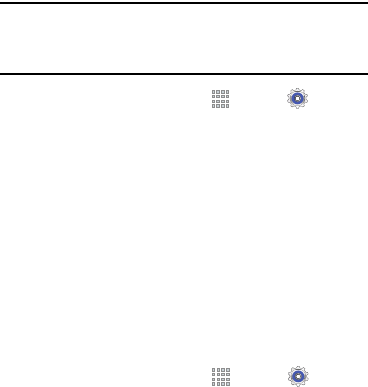
Getting Started 13
Removing a Memory Card
Important!
To prevent damage to information stored on the
memory card, unmount the card before removing it
from the device.
1. From a Home screen, touch
Apps
➔
Settings
➔
General
tab
➔
Storage
.
2. Under
SD card
, touch
Unmount SD card
and then
touch
OK
.
3. Open the Memory Card Slot cover and turn to expose
the slot.
4. Gently press down on the memory card, so that it pops
out from the slot, and carefully pull the card out.
5. Replace the Memory Card Slot cover.
Formatting a Memory Card
Formatting erases all content from the memory card and
prepares it for use with your device.
1. From a Home screen, touch
Apps
➔
Settings
➔
General
tab
➔
Storage
.
2. After mounting the SD card, touch
Format SD card
.
3. Follow the prompts to confirm the formatting of
the card.
DRAFT For Internal Use Only

14
Securing Your Device
By default, the device locks automatically when the screen
times out or you can lock it manually. You can unlock the
device using one of the default Unlock screens or, for
increased security, use a personal screen unlock pattern.
For more information about creating and enabling a Screen
unlock pattern, see “More Networks” on page 118.
For other settings related to securing your device, see
“Location Services” on page 118.
Note:
Unless stated otherwise, instructions in this User Manual
start with the device unlocked, at the Home screen.
Locking the device
䡲
Press the
Power/Lock Key
.
Unlocking the device
䡲
Press the
Power/Lock Key
, and then swipe across the
screen as shown.
DRAFT For Internal Use Only

Understanding Your Device 15
Section 2: Understanding Your Device
This section outlines key features of your device and
describes the screen and the icons that appear when the
device is in use. It also shows how to navigate through
the device.
Features
•
10.1-inch WQXGA (2560x1600) TFT (PLS) LCD touch screen
•
Android Version: Jelly Bean 4.3
•
Wi-Fi, 1.9 GHz dual-core processor
•
Full HTML Web Browser
•
Bluetooth 4.0 Wireless technology. For more information, refer to
“Bluetooth”
on page 87.
•
Built-in Wi-Fi technology (802.11 a/b/g/n/ac)
•
8 megapixel camera and camcorder, plus 2 megapixel full HD
forward-facing camera for video chat
•
Full integration of Google applications (Gmail, YouTube,
Google Maps, and Voice Search)
•
Photo gallery that supports GIF, AGIF, JPEG, PNG, BMP, WBMP, and
WEBP formats
•
Messaging Features:
–
Gmail
–
Email (corporate and personal)
–
Google Hangouts
(Instant Messaging and Video Chat)
•
HD Video Player (1080p)
–
Codec: MPEG4, H.264, H.263, VC-1, VP8, WMV7/8,
Sorenson Spark, MP43
–
Format: AVI, MP4, 3GP, MKV, WMV, ASF, FLV
•
Music player that supports MP3, AAC/AAC+/EAAC+, WMA, Vorbis,
FLAC, AC-3, AMR-NB/WB, WAV
•
Support for microSD and microSDHC
memory cards
•
Preloaded applications such as AllShare Play, Google Play Books,
Google Play
Store, Music Hub, and Polaris Office.
DRAFT For Internal Use Only
16
Front and Sides
The following items can be found on the front and sides of
your device as illustrated.
1.
Light Sensor
: Used to control screen brightness
automatically when taking photos with the front-facing
Camera.
2.
Front-facing Camera Lens
: Used when taking photos or
recording videos.
3.
3.5mm Headset Jack
: Plug in for headphones.
4.
External Speakers
: Used in music or video playback,
notification tones, and for other sounds.
5.
Display Screen
: The orientation of the display screen
rotates with the tablet as you turn it. You can turn this
feature on and off. For more information, refer to
“Rotating the Screen” on page 25.
6.
Memory Card Slot
: Install a memory card for storage
of files.
7.
Menu
: Display a list of options.
8.
Home
: Display the central Home screen. Touch and
hold to display recent apps that have been accessed.
9.
Back
: Return to the previous screen or option.
DRAFT For Internal Use Only
Understanding Your Device 17
Back, Top, and Bottom
The following items can be found on the back, top, and
bottom of your device as illustrated.
1.
Flash
: Provides adequate light when taking pictures in
dark places.
2.
Camera Lens
: Used when taking photos or recording
videos.
3.
Infrared Blaster
: Emits infrared signals used for
controlling external devices.
4.
Volume Key
: From a Home screen, press to adjust
Master Volume. During music playback, press
to adjust
volume.
5.
Power/Lock Key
: Press and hold to turn the device on or
off. Press to lock the device or to wake the screen for
unlocking.
6.
S Pen
: A built-in stylus that allows you to perform
various functions. For more information, refer to
“S Pen” on page 28.
7.
Charger/Accessory Port
: Plug in a USB cable for
charging or to sync music and files.
8.
Microphone
: Used for video chat.
DRAFT For Internal Use Only

18
Home Screen
The Home screen is the starting point for using your device.
Note:
Unless stated otherwise, instructions in this user manual
start with the device unlocked, at the Home screen.
1.
System Bar
: The area along the bottom of the Home
screen where you can find navigation buttons and
icons that show notifications, battery power, and
connection details.
2.
Status Icons
: Indicate the status of your tablet. Touch
the Time / Status Icons area to display the Status
Details panel. For more information, refer to “Indicator
Icons” on page 37.
3.
Time
: The current time. For more information, refer to
“Date and Time” on page 140.
4.
Widgets
: Applications that run on the Home screen.
Some widgets are found on the Home screen by
default. For more information, refer to “Widgets” on
page 39.
5.
Home screen
: The starting point for using your device.
Place shortcuts, widgets, and other items to customize
your device to your needs.
6.
Primary Shortcuts
: Shortcuts to common features.
These shortcuts are found on all Home screens by
default. For more information, refer to “Primary
Shortcuts” on page 38.
DRAFT For Internal Use Only

Understanding Your Device 19
7.
Google Search
: Search the web by typing or speaking.
For more information, refer to “Google Search” on
page 87.
8.
Apps
: Display the Apps screen.
Extended Home Screen
The Home screen consists of the Home panel plus additional
panels that extend beyond the display width to provide more
space for adding shortcuts and widgets. For more
information, refer to “Adding and Removing Home Screen
Panels” on page 20.
Slide your finger horizontally across the screen to scroll to
the left or right side panels.
Note:
The center panel displays when you touch
Home
.
Customizing the Home Screens
To customize the Home screens to suit your preferences:
1. Navigate to one of the Home screen panels.
2. Touch and hold on the screen until the
Home screen
pop-up displays.
3. Touch
Set wallpaper
to change the Home screen
wallpaper. For more information, refer to “Wallpapers”
on page 41.
4. Under
Add to Home screen
touch:
• Apps and widgets
to add app or widget shortcuts on the
Home screen.
•Folder
to add a folder on a Home screen. For more
information, refer to
“Folders”
on page 40.
•Page
to add a Home screen.
Display Settings
You can customize display screen settings to your
preferences. For more information, refer to “Display” on
page 123.
DRAFT For Internal Use Only

20
Adding and Removing Home Screen Panels
Your device comes with seven Home screen panels. You can
customize the Home screen by removing or adding panels.
Note:
The panel in the center position displays when you touch
Home
.
䡲
From a Home screen, pinch the screen from the left
and right side to the center to display the editing
screen.
Tip: Tip:
Touch and hold on the screen until the
Home screen
pop-up displays. Under
Add to Home screen
, touch
Page
to
add a Home screen.
Use these controls to configure panels:
1.
Remove
: Touch and drag a panel to the Trash Can to
remove the panel from the Home screen.
2.
Default Home Page
: Touch the Home icon on a panel to
set it as the default home screen.
3.
Add
: Touch to add a new panel, up to a total of seven.
This option is available when less than seven panels
have been added.
To rearrange the order of panels:
䡲
Touch and drag a panel to a new location.
To return to the Home screen:
䡲
Touch
Back
.
DRAFT For Internal Use Only
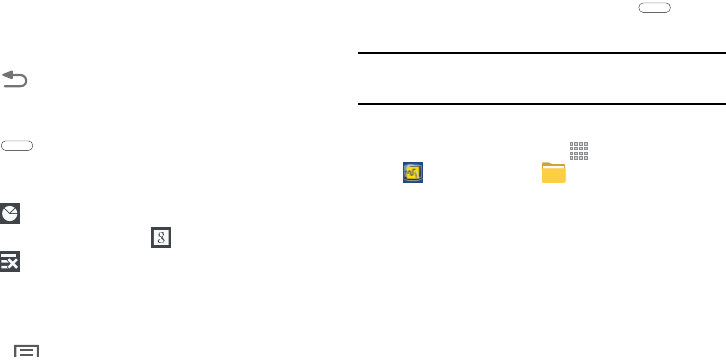
Understanding Your Device 21
Navigating Your Device
Use command buttons and the touch screen to navigate.
Command Buttons
Back
Touch
Back
to return to the previous screen, option,
or step.
Home
Touch
Home
to display the center Home screen.
Touch and hold to open a list of thumbnail images of apps
you have worked with recently. Touch an App to open it.
Touch to display the Task Manager.
To launch Google Search, touch .
Touch to clear all thumbnail images.
Context-Sensitive Menus
Context-sensitive menus offer options for features or
screens. To access context-sensitive menus:
• Touch
Menu
to display a list of options.
• Touch an option in the list.
Screen Capture
䡲
Touch and hold the
Power/Lock Key
and
Home
to
capture and save an image of the current screen.
Note:
A copy of the screenshot is automatically saved to the
clipboard.
To view the screen shots:
1. From a Home screen, touch
Apps
➔
Samsung
folder ➔
My Files
.
2. Touch
storage
➔
Device storage
➔
Pictures
➔
Screenshots
.
3. Touch a screen capture file to display it.
Application Bar
The Application Bar is the area along the top of various
application screens. It usually contains the Search and Menu
icons, as well as other icons that are used to display options
and settings.
DRAFT For Internal Use Only
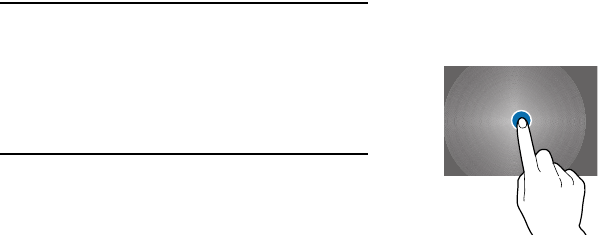
22
Using the Touch Screen
Use only fingers or the S Pen to use the touch screen.
Caution!
Do not allow the touch screen to come into contact
with other electrical devices. Electrostatic discharges
can cause the touch screen to malfunction.
To avoid damaging the touch screen, do not tap it
with anything sharp or apply excessive pressure to it
with your fingertips.
Finger Gestures
Touching
To open an application, to select a menu item, to press an
on-screen button, or to enter a character using the on-screen
keyboard, touch it with a finger.
DRAFT For Internal Use Only

Understanding Your Device 23
Touching and Holding
Touch and hold an item for more than 2 seconds to access
available options.
Dragging
To move an icon, thumbnail, or preview to a new location,
touch and hold it and drag it to the target position.
DRAFT For Internal Use Only
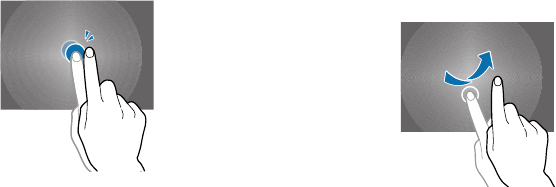
24
Double-Tapping
Double-tap on a webpage, map, or image to zoom in a part.
Double-tap again to return.
Flicking
Flick left or right on the Home screen or the Applications
screen to see another panel. Flick up or down to scroll
through a webpage or a list, such as contacts.
DRAFT For Internal Use Only
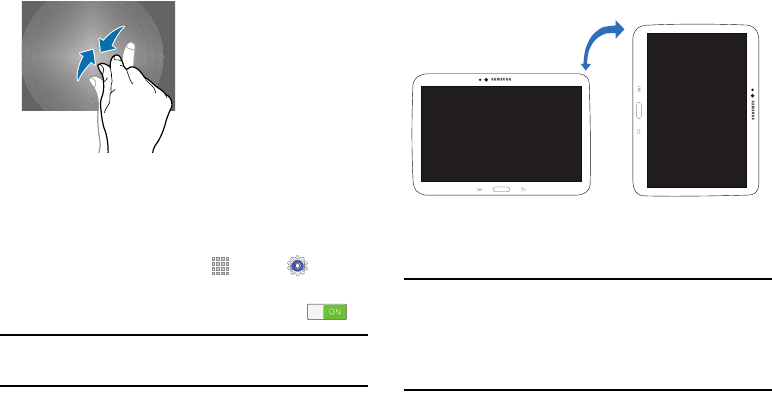
Understanding Your Device 25
Pinching
Spread two fingers apart on a webpage, map, or image to
zoom in a part. Pinch to zoom out.
Control Motions
Simple motions allow easy control of the device.
Before using motions, make sure the motion feature is
activated.
1. From a Home screen, touch
Apps
➔
Settings
➔
Controls
tab ➔
Motions
.
2. Touch the
OFF/ON
button to turn Motions
ON
.
Note:
Excessive shaking or impact to the device may result in
unintended inputs. Control motions properly.
Rotating the Screen
Many applications allow display in either portrait or
landscape orientation. Rotating the device causes the display
to automatically adjust to fit the new screen orientation.
To prevent the display from rotating automatically, open the
notifications panel and deselect
Screen rotation
.
Note:
Some applications do not allow screen rotation.
Some applications display a different screen depending
on the orientation. The calculator turns into a scientific
calculator when rotated to landscape.
DRAFT For Internal Use Only
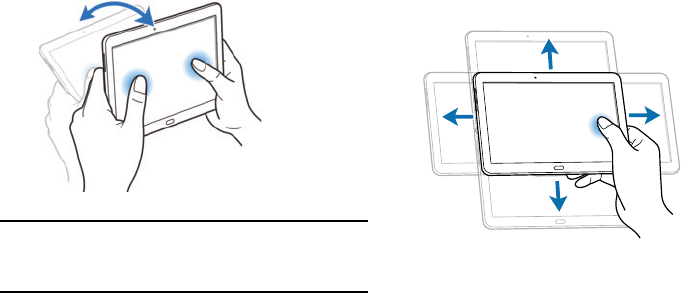
26
Tilting
Touch and hold two points on the screen, and then tilt the
device back and forth to zoom in or out.
Note:
To move an icon to a new location, touch and hold it and
drag it to the target position. For more information, refer
to “Dragging” on page 23.
Panning to Browse
When an image is zoomed in, touch and hold a point on the
screen, and then move the device in any direction to browse
the image.
DRAFT For Internal Use Only
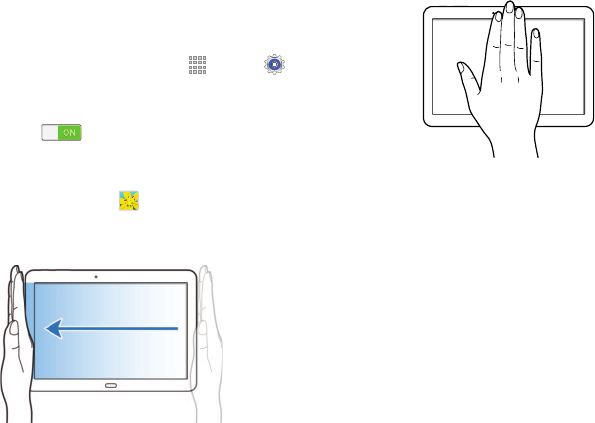
Understanding Your Device 27
Palm Motions
Use palm motions to control the device by touching the
screen.
Before using motions, make sure the palm motion feature is
activated.
1. From a Home screen, touch
Apps
➔
Settings
➔
Controls
tab ➔
Palm motion
.
2. Touch the
OFF/ON
button to turn Palm motion
ON
.
Sweeping
Sweep your hand across the screen to capture a screenshot.
The image is saved in
Gallery
➔
Screenshots
. It is not
possible to capture a screenshot while using some
applications.
Covering
Cover the screen with a palm to pause media playback.
DRAFT For Internal Use Only
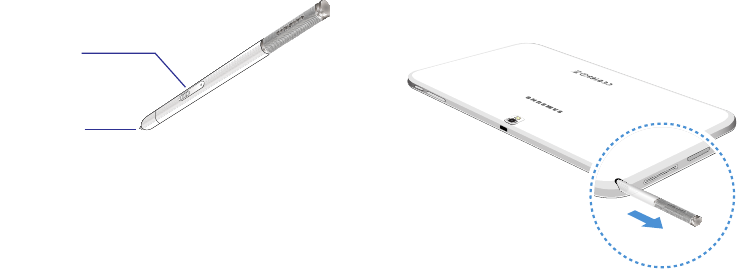
28
SPen
The S Pen is a stylus that assists you in performing different
functions. By using the Pen button, you can minimize having
to switch between touch and pen input.
Using the S Pen
The included S Pen can be used to easily select items or
perform functions. Actions using the S Pen with the button
pressed provide additional conveniences, such as screen
capture.
Pull out the S Pen from the slot to use it.
S Pen Button
S Pen Tip
DRAFT For Internal Use Only
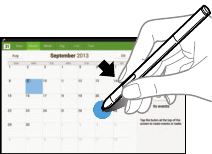
Understanding Your Device 29
When you pull out the S Pen from the slot, the device detects
it and performs the following:
•
Turns on the touch screen (if it is off).
•
Launches action memo, or display general air commands.
Notes:
•
The pen nib of the S Pen is replaceable. If the pen nib gets dull,
replace it with a new one.
•
If the S Pen is not working properly, take it to a Samsung Service
Centre. Refer to the Samsung website for more information about
the S Pen.
•
For best results, keep the S Pen mostly perpendicular to the touch
screen and avoid using it at sharp angles.
•
The Menu button and the Back button cannot be activated by the
S Pen.
Capturing Screenshots
With the S Pen button pressed, touch the screen until you
hear a click. A screenshot is saved in the
Gallery
➔
Screenshots
folder.
It is possible to draw or write on or to crop a screenshot. The
edited image is saved in the
Gallery
➔
Screenshots
folder.
It is not possible to capture a screenshot while using some
applications.
DRAFT For Internal Use Only
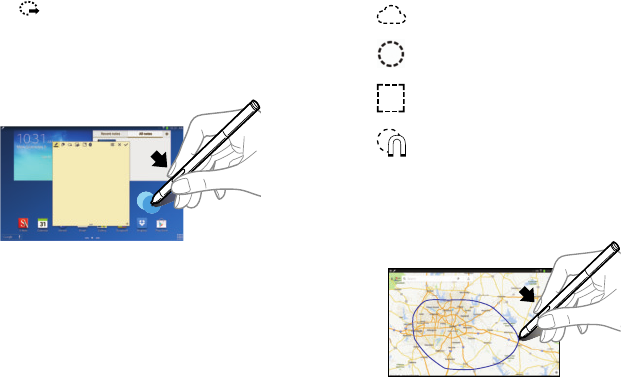
30
Launching Action Memo
With the S Pen button pressed, double-tap the screen to
launch action memo.
Jot down or draw a note, and then select the memo by
tapping to perform various actions, such as adding
contacts or sending a email. With the memo selected, draw a
line around an area with the S Pen to perform actions with
the selected area.
Selecting and Capturing an Image
With the S Pen button pressed, draw a line around an area to
select it.
If necessary, use one of the following options:
Select an application to use with the selected area from the
icons that appear at the bottom of the screen.
Restore the original selection.
Convert the selection to circular shape.
Convert the selection to rectangular shape.
Customize the selection.
DRAFT For Internal Use Only
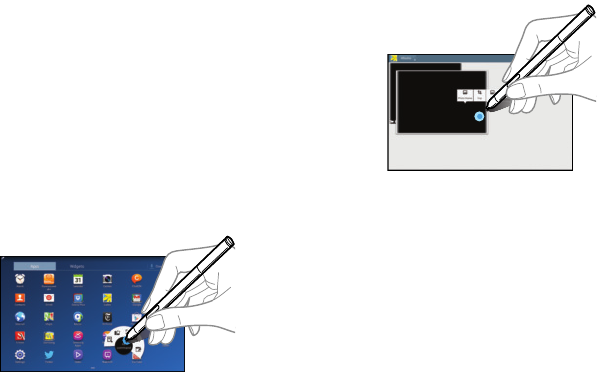
Understanding Your Device 31
Using Air Command
Press the S Pen button while hovering the S Pen over the
screen.
In most cases, general air commands appear on the screen
when pressing the S Pen button.
Use the following actions:
•
Action Memo
: Launch action memo.
•
Scrap booker
: Select and capture an image, and then save the
image into Scrapbook.
•
Screen Write
: Capture a screenshot and edit it with the S Pen.
•
S Finder
: Launch S Finder.
•
Pen Window
: Launch multiple applications in specified areas on
the screen.
Some items have contextual menus that make the S Pen
pointer glow. Press the S Pen button to display the menu
while hovering the S Pen over the item.
DRAFT For Internal Use Only
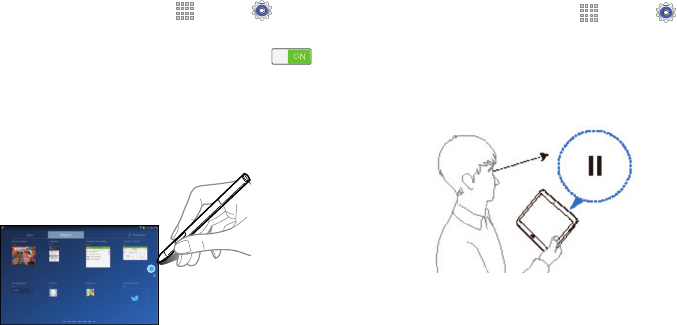
32
Air View
Use this feature to perform various functions while the S Pen
is hovering over the screen.
1. From a Home screen, touch
Apps
➔
Settings
➔
Controls
tab ➔
S Pen
➔
Air view
.
2. Touch the
OFF/ON
button to turn Air view
ON
.
Point at an item with the S Pen to preview content or view
information in a pop-up window.
You can scroll through panels or lists by moving the S Pen
pointer to an edge (top/bottom/left/right) of the screen.
For more information, refer to “S Pen” on page 28.
Samsung Smart Pause
Use this feature to pause videos when you look away from
the screen.
1. From a Home screen, touch
Apps
➔
Settings
➔
Controls
tab ➔
Smart screen
.
2. Touch
Smart pause
to enable it.
During video playback, look away from the screen to pause
the video. To resume playback, look at the screen again.
DRAFT For Internal Use Only

Understanding Your Device 33
Samsung Smart Scroll
Use this feature to scroll the screen up or down by tilting your
head or the device.
1. From a Home screen, touch
Apps
➔
Settings
➔
Controls
tab ➔
Smart screen
➔
Smart scroll
.
2. Touch the
OFF/ON
button to turn Smart scroll
ON
.
3. Touch
Smart scroll
and select a scroll type.
When you are viewing email or webpages, the scroll type
icon ( for head orientation or for tilting the device)
that shows the recognition status for movements appears
in blue.
When the device recognizes your head or device’s
movements, the icon turns green. Tilt your head downward
or upward, or tilt the device forward or backward to scroll in
that direction.
Activating Multi Window
Use this feature to run two applications on the screen at the
same time.
Notes:
•
Only applications on the Multi Window panel can run.
•
When launching applications that contain multimedia files, such
as music or videos, sound from both files will be played.
•
This feature may not be available depending on the region or
service provider.
DRAFT For Internal Use Only
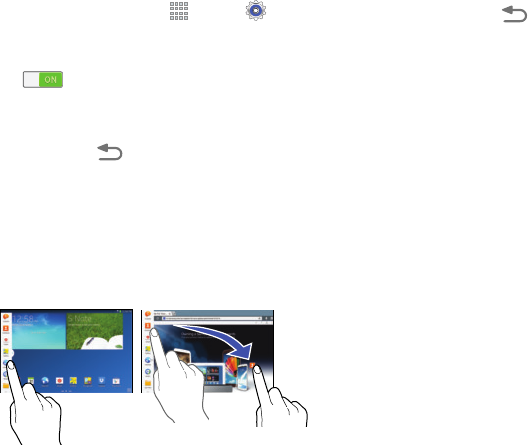
34
To use Multi Window:
1. From a Home screen, touch
Apps
➔
Settings
➔
Device
tab.
2. Touch the
OFF/ON
button to turn Multi window
ON
.
Using the Multi Window Panel
To show the Multi Window panel:
1. Touch and hold
Back
.
The Multi Window panel appears on the left side of the
screen.
2. Select one application, and then drag another
application to a new location.
You can launch the same application on the two
windows at the same time.
To hide the Multi Window panel:
䡲
Touch and hold
Back
again.
Drag the circle between the application panels left or right to
adjust the size of the panels.
Touch the panel handle to hide or show the panel. When a
panel is open, touch and hold the handle and drag it to the
left or right edge of the screen to move the panel. When a
panel is hidden, touch and hold the handle and drag it up or
down to move the handle.
DRAFT For Internal Use Only

Understanding Your Device 35
Using Multi Window Applications
While using Multi Window applications, select an application
panel, touch the circle between the application panels, and
then use one of the following:
Sharing Files
Drag an item you want to share to the other window to share
the item from one window to another.
Creating a Paired Window
Use this feature to save the combination of current running
Multi Window applications.
On the Multi Window panel:
1. Touch ➔
Create
.
2. Enter a title and then touch
OK
.
Notifications
Notification icons appear on the status bar at the top of the
screen to report new messages, calendar events, device
status, and more. Drag down from the status bar to open the
notifications panel. Scroll the list to see additional alerts. To
close the notifications panel, drag up the bar that is at the
bottom of the screen.
Switch app to compact screen.
Switch locations between Multi Window
applications.
Share items between the application windows.
Drag an item to share from one window to another.
Some applications may not support this feature.
Close the application.
DRAFT For Internal Use Only
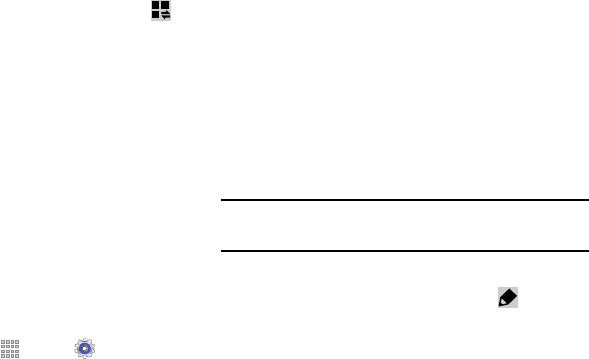
36
Notifications Panel
From the notifications panel, you can view your device’s
current settings. Drag down from the status bar, touch
to open the notifications panel, and then use the following
options:
•
Wi-Fi
: Activate or deactivate the Wi-Fi feature.
•
GPS
: Activate or deactivate the GPS feature.
•
Sound
: Activate or deactivate silent mode. You can vibrate or
mute your device in silent mode.
•
Screen rotation
: Allow or prevent the interface from rotating
when you rotate the device.
•
Bluetooth
: Activate or deactivate the Bluetooth feature.
•
Reading mode
: Activate or deactivate reading mode, which
optimizes the screen for reading.
•
Blocking mode
: Activate or deactivate blocking mode. In
blocking mode, the device will block notifications. To select which
notifications will be blocked:
–
From a Home screen, touch
Apps
➔
Settings
➔
Device
tab
➔
Blocking mode
.
•
Power saving
: Activate or deactivate power-saving mode.
•
Multi window
: Set to use Multi Window.
•
Screen Mirroring
: Activate or deactivate the screen mirroring
feature.
•
Air view
: Activate or deactivate the air view feature.
•
Smart stay
: Activate or deactivate the smart stay feature.
•
Smart pause
: Activate or deactivate the smart pause feature.
•
Smart scroll
: Activate or deactivate the smart scroll feature.
•
Sync
: Activate or deactivate auto-syncing of applications.
•
Airplane mode
: Activate or deactivate airplane mode.
Note:
The available options may vary depending on the region
or service provider.
To rearrange the options on the notifications panel:
1. Open the notifications panel and touch .
2. Touch and hold an item, and then drag the item to
another location.
DRAFT For Internal Use Only
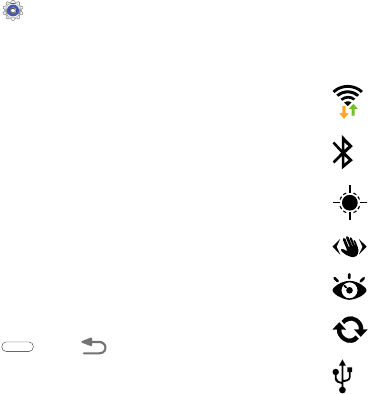
Understanding Your Device 37
To open the Settings application:
䡲
Touch
Settings
. For more information, refer to
“Settings” on page 116.
To set brightness options:
䡲
Touch the
Brightness
slider and drag it to set the
brightness or touch
Auto
to allow the device to set
brightness automatically based on available light and
battery charge status. For more information, refer to
“Display” on page 123.
Notifications
displays system notifications.
䡲
Touch a notification entry to display the details. Touch
Clear
to remove Notification Icons from the System Bar.
For more information, refer to “Notifications” on
page 35.
To close the Notification Panel:
䡲
Touch
Home
,
Back
, or swipe up.
Indicator Icons
The icons displayed at the top of the screen provide
information about the status of the device. The icons listed in
the table below are most common.
Wi-Fi connected
Bluetooth feature activated
GPS activated
Air gesture feature activated
Smart screen feature activated
Synced with the web
Connected to computer
DRAFT For Internal Use Only

38
Primary Shortcuts
Primary Shortcuts display at the bottom of the Home
screens.
Tip:
The main Home screen is usually the center Home screen.
The default Primary Shortcuts are: S Note, Calendar, Internet,
Email, Gallery, Scrapbook, Dropbox, Play Store.
Other App Shortcuts
There are also other application shortcuts on the Home
screens, such as Dropbox, Samsung Apps, and Play Store.
For more information, refer to “More Application Information”
on page 53.
Application shortcuts can be added to any Home screen. For
more information, refer to “App Shortcuts” on page 39.
Alarm activated
S Pen removed
Silent mode activated
Vibration mode activated
Airplane mode activated
Error occurred or caution required
Battery power level
DRAFT For Internal Use Only
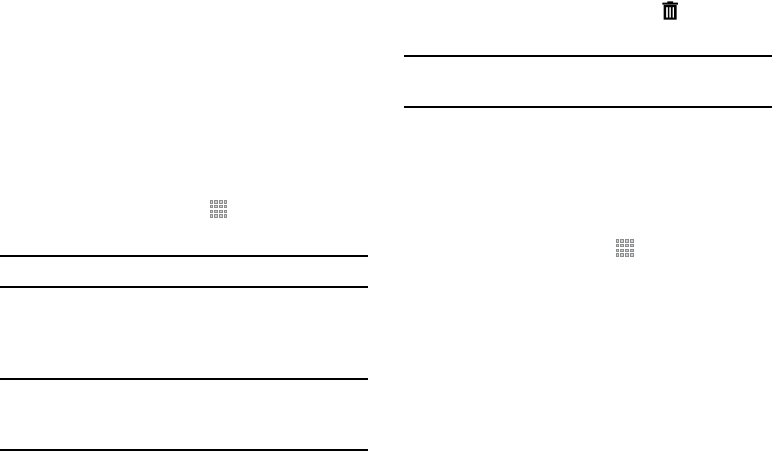
Understanding Your Device 39
Widgets
When you first turn on your tablet, there are various widgets
on the center Home screen. They can also appear on the
Home screens to the left and right of the center Home
screen.
Widgets are self-contained applications that you can place
on the Home screens to access your favorite features.
For more information, refer to “Applications” on page 91.
Adding Widgets to a Home screen
1. Navigate to the Home screen on which you want to
place the Widget and touch
Apps
.
2. Touch the
Widgets
tab.
Note:
Swipe across the screen horizontally to view all Widgets.
3. Touch and hold the widget’s icon until the Home screen
displays, then slide your finger where you want to
place the icon and release it.
Note:
There must be room on the screen where you want to
place the widget, otherwise the widget will not add to
the Home screen.
Removing Widgets
䡲
Touch and hold the Widget until the
Remove
icon
displays, then drag the widget to the
Remove
icon.
Note:
This action does not actually delete the Widget, it just
removes it from the current Home screen.
App Shortcuts
Use App Shortcuts for quick access to applications or
features, such as Email or other applications.
1. Navigate to the Home screen on which you want to
place the App Shortcut.
2. From a Home screen, touch
Apps
.
– or –
Touch and hold on the screen until the
Home screen
options pop-up displays and then touch
Apps and
widgets
.
3. Touch the
Apps
tab.
DRAFT For Internal Use Only

40
4. Touch and hold the application icon until the Home
screen displays, then slide your finger where you want
to place the icon and release it.
For more information, refer to “Apps Screen” on
page 42.
5. Touch and hold the App Shortcut and then drag the
application icon to reposition it on the Home screen.
Removing App Shortcuts
䡲
Touch and hold the App Shortcut until
Remove
displays, then drag the App Shortcut to the
Remove
icon.
Folders
Place Folders on a Home screen to organize items together.
Adding Folders
To create a folder on a Home page:
1. Navigate to the desired Home screen.
2. Touch and hold on the screen until the
Home screen
pop-up displays and then touch
Folder
.
The Create folder pop-up displays.
3. Touch the
Enter folder name
field, use the keyboard to
enter a name for the folder, and touch
OK
.
A new folder displays on the Home screen.
Managing Folders
To rename a folder:
䡲
Touch the folder, touch the current name, and use the
keyboard to enter a new name for the folder.
DRAFT For Internal Use Only

Understanding Your Device 41
To add an App shortcut to a folder:
1. Add the App shortcut to the Home screen that the
folder is on.
2. Touch and hold the App shortcut, drag it to the folder,
and drop it.
To remove an App shortcut from a folder:
1. Touch the folder to view the contents.
2. Touch the App shortcut, drag it out of the folder, and
drop it on the Home screen.
Removing a Folder
䡲
Touch and hold the folder until the
Remove
icon
displays, then drag the folder to the
Remove
icon.
Note:
Any App shortcuts in the folder are also removed.
Wallpapers
You can choose a picture to display on the Home Screen,
Lock screen, or on both the Home and Lock screens. Choose
from preloaded wallpaper images or select a photo you have
downloaded or taken with the Camera.
1. From a Home screen, touch and hold on the screen.
The
Home screen
options pop-up displays.
2. Touch
Set wallpaper
.
The Set wallpaper pop-up displays.
3. Touch
Home screen
,
Lock screen
, or
Home and lock
screens
.
The
Select wallpaper from
pop-up displays the
following options:
•Gallery
: Access the Gallery to select a photo. Touch a photo to
select it. Crop and resize the picture, if desired. Touch
Done
to
save the picture as wallpaper. Touch
Cancel
to cancel.
• Live wallpapers
: Choose from pre-loaded interactive animated
wallpapers. Touch a wallpaper to see an example. If available,
touch
Settings
to view options for the selection. Touch
Set
wallpaper
to save your choice. Touch
Back
to return to
the Live wallpapers menu.
DRAFT For Internal Use Only

42
• Wallpapers
: Choose from pre-loaded wallpaper images. Touch
an image to view it. Touch
Set wallpaper
to save it as
wallpaper. Touch
Back
to return to the Home screen.
Note:
Live wallpapers is not available for the Lock screen.
Apps Screen
The
Apps
screen displays all applications installed on your
wireless device. Applications that you download and install
from Google Play or from the web are also added to a Home
screen.
The Apps icons are arranged in a customizable grid. To
arrange the Apps icons in alphabetical order:
1. From a Home screen, touch
Apps
.
2. Touch
Menu
➔
View type
.
3. Touch
Alphabetical grid
.
To manually change the order of the icons on the Apps
screen:
1. From a Home screen, touch
Apps
.
2. Touch
Menu
➔
Edit
.
3. Touch and hold an icon and drag it to a new position.
4. Touch
Save
to save the changes.
You can place shortcuts to applications on the Home screen
for quick access to the application. For more information,
refer to “App Shortcuts” on page 39.
To view your downloaded applications:
1. From a Home screen, touch
Apps
.
2. Touch
Download
to view downloaded apps.
3. Touch an icon on the
Downloaded applications
screen
to launch the application.
– or –
Add an App Shortcut to a Home screen by dragging the
App icon onto the Home Screen. For more information,
refer to “App Shortcuts” on page 39.
Entering Text
Use the Samsung keyboard or the voice input feature to
enter text.
DRAFT For Internal Use Only
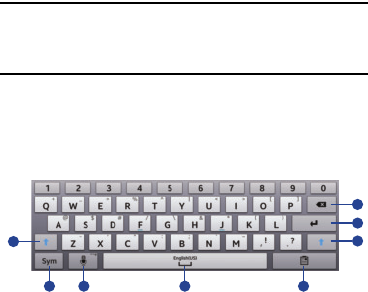
Understanding Your Device 43
Note:
Text entry is not supported in some languages. To enter
text, you must change the input language to one of the
supported languages.
Using the Keyboard
Touch any text field, open the notifications panel, touch
Select input method
, and then select the type of keyboard
to use.
1. Enter uppercase.
2. Enter punctuation marks.
3. Touch for Voice input. Touch and hold to use
Handwriting, display keyboard settings, or change the
keyboard type.
4. Enter a space.
5. Add an item from the clipboard.
6. Break to the next line.
7. Delete a preceding character.
1
2 3 4 5
1
6
7
DRAFT For Internal Use Only
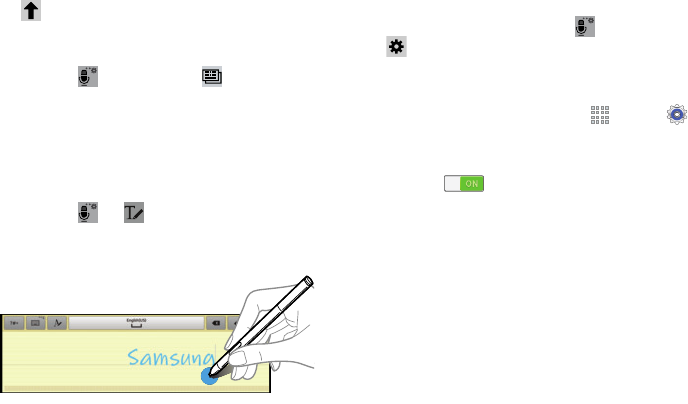
44
Entering Uppercase
Touch before entering a character. For all caps, touch
it twice.
Changing the keyboard type
Touch and hold , and then touch to change the
keyboard type.
Changing language keyboards
Add languages to the keyboard, and then slide the space key
left or right to change language keyboards.
Handwriting
Touch and hold ➔ , and then write a word with a
finger or the S Pen. Suggested words appear as characters
are entered. Select a suggested word.
Use handwriting gestures to perform actions, such as editing
or deleting characters and inserting spaces. To view the
gesture guides, touch and hold , and then touch
Settings
➔
Help
➔
Keyboard
➔
Use handwriting
gestures
.
Direct Pen Input
1. From a Home screen, touch
Apps
➔
Settings
➔
Controls
tab ➔
S Pen
➔
Direct pen input
.
2. Touch the
OFF/ON
button to turn Direct pen input
ON
.
DRAFT For Internal Use Only
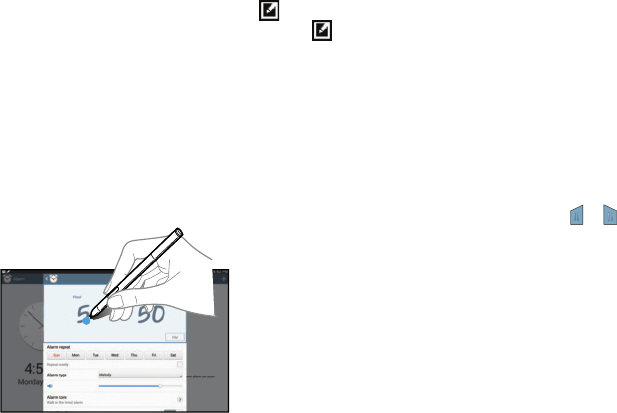
Understanding Your Device 45
When hovering the S Pen over a text field, the icon
appears at the upper left corner of the text field. Touch
to write with the S Pen.
To make simple corrections, change input languages, or
enter a space between characters, touch each correction tool
displayed on the handwriting pad.
When this feature is enabled, you can do the following
actions:
•
Send a handwritten message.
•
Set an alarm just by writing numbers.
Entering Text By Voice
Activate the voice input feature and then speak into the
microphone. The device displays what you speak.
If the device does not recognise your words, touch the
underlined text and select an alternative word or phrase from
the dropdown list.
To change the language or add languages for voice
recognition, touch the current language.
Copying and Pasting
Touch and hold over text, drag or to select more or less
text, and then touch
COPY
to copy or
CUT
to cut. The selected
text is copied to the clipboard.
To paste it into a text entry field, touch and hold at the point
where it should be inserted, and then touch
PASTE
.
DRAFT For Internal Use Only

46
Section 3: Accounts and Contacts
This section explains how to manage accounts and contacts.
Accounts
Your device can synchronize with a variety of accounts. With
synchronization, information on your device is updated with
any information that changes in your accounts.
•
Samsung Account
: Add your Samsung Account.
•
ChatON
: Add your ChatON Account.
•
Dropbox
: Add your Dropbox Account.
•
Email
: Add an Email Account to sync Contacts.
•
Evernote
: Add an Evernote Account.
•
Google
: Add your Google Account to sync your Contacts, Calendar,
and Gmail.
•
LDAP
: Add an LDAP Account to find entries in an LDAP directory
server.
•
Microsoft Exchange ActiveSync
: Add your Exchange Account to
sync Contacts, Calendar, and Email.
•
Server
: Add a Server to sync and access your data.
•
Facebook
: Add a Facebook Account to sync apps.
•
Twitter
: Add a Twitter Account.
Setting Up Accounts
Set up and manage your synchronized accounts with the
Accounts
setting.
1. From a Home screen, touch
Apps
➔
Settings
➔
General
tab
➔
Accounts
➔
Add account
.
2. Touch the account type.
3. Follow the prompts to enter your account credentials to
complete the set up process.
Your tablet communicates with the appropriate account
servers to set up your account. When complete, your
account displays in the
Accounts
area of the Settings
screen.
DRAFT For Internal Use Only
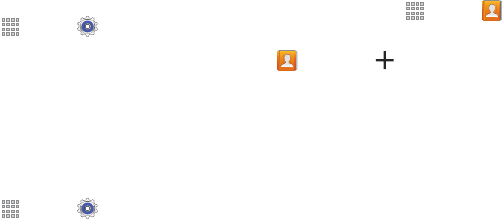
Accounts and Contacts 47
Your Google Account
In order to utilize your device to the fullest extent, you will
need to create a Google Account when you first use your
device. With a Google Account, Google applications will
always be in sync between your tablet and computer.
If you need to create a Google account, follow these steps:
1. From a Home screen, touch
Apps
➔
Settings
➔
General
tab ➔
Accounts
➔
Add account
➔
Google
.
2. Follow the prompts to sign into your existing account or
create a new account.
Your Samsung Account
Create a Samsung Account for access to Samsung apps
and services, such as Samsung Hub, Samsung Apps,
Samsung Link, and much more.
1. From a Home screen, touch
Apps
➔
Settings
➔
General
tab ➔
Accounts
➔
Add account
➔
Samsung account
.
2. Follow the prompts to sign into your existing account or
create a new account.
Contacts
Store contact information for your friends, family, and
colleagues to quickly access information or to send a
message.
To access Contacts:
䡲
From a Home screen, touch
Apps
➔
Contacts
.
Add a Contact
1. Touch
Contacts
➔
Create
. The Save contact to
pop-up displays.
2. To choose where the contact is stored, touch
Device
or
an account.
– or –
Touch
Add new account
to add a different account. For
more information, refer to “Setting Up Accounts” on
page 46.
DRAFT For Internal Use Only
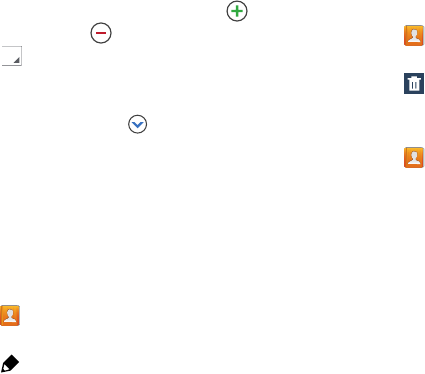
48
3. Touch each field to enter information. Touch to
add another entry, or to remove an entry.
Touch to choose a label.
•Picture
: Touch the picture icon to assign a picture to the new
contact.
•Name
: Enter the name. Touch to display additional name
fields.
• Phone
: Enter a phone number.
•Email
: Enter an email address.
•Groups
: Assign the contact to a group.
• Add another field
: Add additional fields for the contact.
4. Touch
Save
.
Updating Contacts
1. Touch
Contacts
.
2. Touch a contact in the Contacts list to display it.
3. Touch
Edit
.
4. Touch any field to edit. For more information, refer to
“Add a Contact” on page 47.
Deleting Contacts
1. Touch
Contacts
.
2. Touch a contact in the Contacts list to display it.
3. Touch
Delete
.
Contacts Display Options
There are various ways to display your contacts.
1. Touch
Contacts
.
2. Touch the
Groups
tab,
Favorites
tab, or
Contacts
tab to
view contacts in various ways:
•Groups
: Display contacts sorted into groups—such as
Not assigned, Co-workers, Family, Friends, etc. The number of
contacts in each group is displayed next to the group name.
Touch a group name to show only contacts in that group. For
more information, refer to
“Create a New Group”
on
page 51.
•Favorites
: Show only your favorite (or starred), contacts. For
more information, refer to
“Favorites”
on page 53.
•Contacts
: Show all your contacts. Touch the
Search
field and
enter a keyword to list contacts that contain that keyword.
DRAFT For Internal Use Only

Accounts and Contacts 49
3. While viewing
Groups
,
Favorites
, or
Contacts
, touch
Menu
for options.
4. While viewing the
Contacts
tab, touch
Menu
➔
Settings
for Contact settings.
Linked Contacts
Your device can synchronize with multiple accounts,
including Google, Corporate Exchange, and other email
providers. When you synchronize contacts from these
accounts with your device, you may have multiple contacts
for the same person.
Linking, or joining, imported contact records allows you to
see all of a contact’s numbers and addresses together in a
single contact entry. Linking also helps you keep your
contacts updated, because any changes that your contacts
make to their information in the respective accounts are
automatically updated the next time you synchronize with
that account.
Linking Contacts
1. Touch
Contacts
.
2. Touch a contact in the Contacts list to display it.
3. Touch
Menu
➔
Link contact.
4. Touch the contact you want to link. The linked contact’s
information is displayed with the original contact’s
information.
5. Repeat Steps 3 and 4 to link other contacts.
Separating Contacts
1. Touch
Contacts
.
2. Touch a contact in the Contacts list to display it.
3. Touch
Menu
➔
Separate contact.
A list of linked
contacts is displayed.
4. Touch
to separate a linked contact.
DRAFT For Internal Use Only

50
Sharing Contact Information
You can send a contact’s information using Bluetooth to other
Bluetooth devices, or in an Email or Gmail as an attachment.
Note:
Not all Bluetooth devices accept contacts and not all
devices support transfers of multiple contacts. Check
the target device’s documentation.
1. Touch
Contacts
.
2. Touch
Menu
➔
Share namecard via
.
3. Touch
Selected contact
so share only the displayed
contact, or touch
Multiple contacts
.
4. Touch a sending method, such as Bluetooth or email.
5. Follow the prompts to send the contact information.
Importing and Exporting Contacts
To back up and restore your contacts, you can export your
contacts list to a storage device (such as a PC), or import
your contacts list from a storage device.
1. Use the USB cable to connect your device to the
storage device.
2. Touch
Contacts
.
3. Touch
Menu
➔
Import/Export
.
4. Touch an option and then follow the prompts.
DRAFT For Internal Use Only
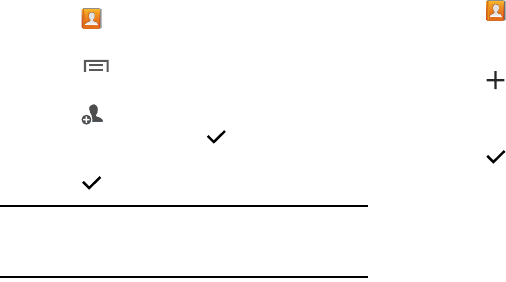
Accounts and Contacts 51
Groups
Assign contacts to Groups to make searching for contacts
faster or to quickly send messages to group members.
Create a New Group
Create a new group when you add or edit a contact.
1. Touch
Contacts
.
2. Touch the
Groups
tab.
3. Touch
Menu
➔
Create
.
4. Touch the
Group name
field enter a name.
5. Touch
Add member
. Touch individual contacts or
touch
Select all
, then touch
Done
to add the
selected contacts to the group.
6. Touch
Save
.
Tip:
Contacts can belong to more than one group. While
editing the contact, touch the
Groups
field to add
additional groups.
Once you create a new group, the Contacts List can be set to
display only the contacts in that group. For more information,
refer to “Contacts Display Options” on page 48.
Adding Group Members
To add a contact to a group, just Edit a contact’s Group field.
For more information, refer to “Updating Contacts” on
page 48.
To add multiple contacts to a group:
1. Touch
Contacts
.
2. Touch
Groups
and then touch the group to which you
want to add members.
3. Touch
Add member
.
The contacts that can be added display.
4. Touch
Select all
or the name of each contact to add.
5. Touch Done to add the contacts to the group.
DRAFT For Internal Use Only

52
Removing Group Members
To remove contacts from a group:
1. Touch
Contacts
.
2. Touch
Groups
and then touch the group from which you
want to remove members.
3. Touch
Menu
➔
Remove member
.
4. Touch
Select all
or the name of each contact to remove.
5. Touch Done to remove the contacts.
Contacts are removed from the group and the group
name is removed from each contact’s
Group
field.
Renaming a Group
1. Touch
Contacts
.
2. Touch the
Groups
tab and touch the group you want to
rename.
3. Touch
Menu
➔
Edit
.
4. Touch the
Group name
field and enter a new name.
5. Touch
Save
.
Deleting Groups
1. Touch
Contacts
➔
Groups
tab ➔
Delete
.
2. Touch individual groups or touch
Select all
, then touch
Delete
.
3. Touch Group only (to delete only the group) or Group
and group members (to delete both the group and the
group’s members).
DRAFT For Internal Use Only
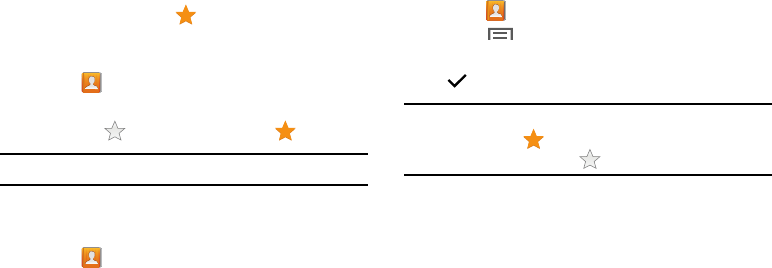
Accounts and Contacts 53
Favorites
Mark contact records with a gold star to identify them as
favorites.
Mark a Contact as a Favorite
1. Touch
Contacts
.
2. Touch a contact in the Contacts list to display it.
3. Touch the
Star
so that it turns gold .
Tip:
You do not have to edit the contact to mark it as a favorite.
View Favorites
There are two ways to view your favorites.
1. Touch
Contacts
.
2. Touch the
Favorites
tab. Only your starred contacts are
displayed.
– or –
Touch the
Groups
tab, then touch
Starred in Android
to
list only your starred contacts that are being saved to
your Google account.
Remove Favorites
1. Touch
Contacts
➔
Favorites
tab.
2. Touch
Menu
➔
Remove from favorites
.
3. Touch individual contacts or touch
Select all
, then touch
Done
to remove.
Note:
To remove the currently displayed contact your favorites
list, touch the
Star
next to the contact’s name so
that it is no longer gold .
DRAFT For Internal Use Only
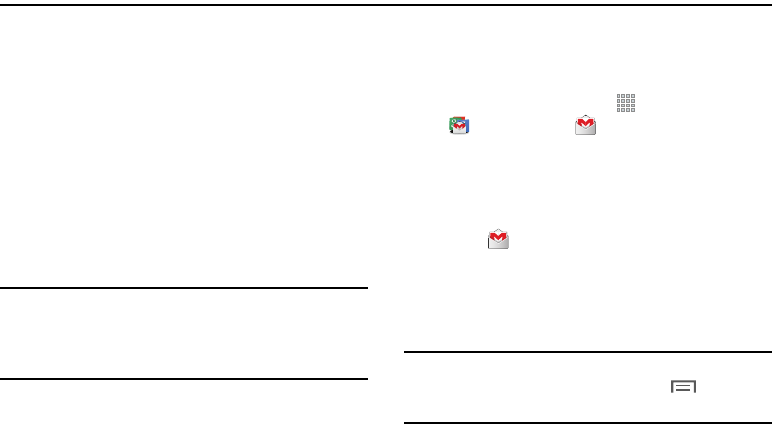
54
Section 4: Messaging
This section describes how to send and receive messages
and other features associated with messaging.
Types of Messages
Your device supports these types of messages:
•
Email
•
Gmail
•
Hangouts
•
Google+
•
Google Messenger
•
ChatON
•
Twitter
Note:
Your Wi-Fi-only device does NOT support voice calling
and messaging services. Please disregard any “dial”
and “message” related menus because some Gmail
options are identically set in all Android devices.
Gmail
Send and receive email with Gmail, Google’s web-based
email service.
䡲
From a Home screen, touch
Apps
➔
Google
folder ➔
Gmail
.
Setting Up Your Gmail Account
If you did not set up a Google account during the initial
configuration, the first time you launch Gmail, your device
prompts you to set up your Google account.
1. Touch
Gmail
.
2. Follow the prompts to sign in or create a new account.
The device communicates with the Google server to set
up your account and synchronize your email. When
complete, your Gmail displays in the Inbox.
Note:
You can use more than one Google account on your
device. To add another account, touch
Menu
➔
Settings
➔
General
tab ➔
Accounts
➔
Add account
.
DRAFT For Internal Use Only
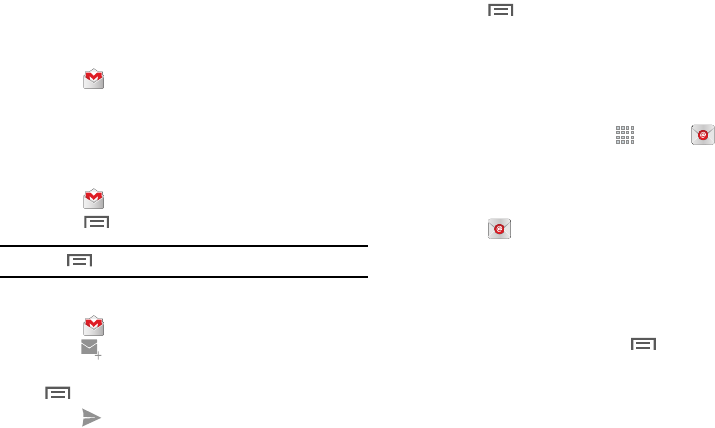
Messaging 55
Refreshing Your Gmail Account
Refresh your account to update your device from the Gmail
servers.
1. Touch
Gmail
.
2. While viewing your Inbox, drag your finger downward
across your messages.
Gmail Settings
Use the Gmail Settings to configure your Gmail preferences.
1. Touch
Gmail
.
2. Touch
Menu
➔
Settings
for settings.
Tip:
Touch
Menu
➔
Help
for more information.
Composing and Sending Gmail
1. Touch
Gmail
.
2. Touch
Compose
, then touch fields to compose
the message. While composing a message, touch
Menu
for options.
3. Touch
SEND
to send this message.
– or –
Touch
Menu
➔
Save draft
to save a draft of this
message.
Email
Use Email to view and manage all your email accounts in one
application.
䡲
From a Home screen, touch
Apps
➔
Email
.
Configuring Email Accounts
You can configure Email for most accounts in just a
few steps.
1. Touch
Email
.
2. The first time you set up an email account, at the Set
up email screen, enter an
Email address
and
Password
,
then touch
Next
.
– or –
For additional accounts, touch
Menu
➔
Settings
➔
Add account
.
3. Follow the on-screen instructions to set up your email
account.
DRAFT For Internal Use Only
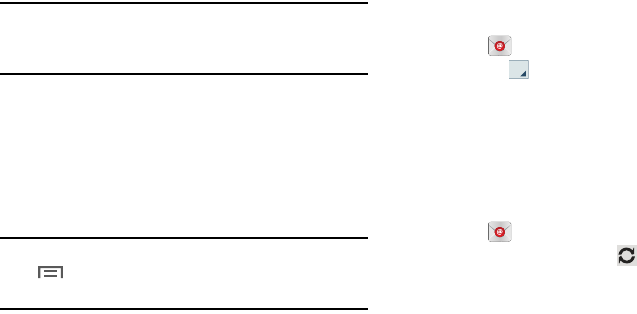
56
4. Touch
Next
to go to the next screen or touch
Previous
to
go to the Apps screen.
Note:
For Exchange ActiveSync accounts, the Activate device
administrator? screen may appear. Read the information
and touch
Activate
to continue.
5. Enter an account name and Your name, if required.
6. Touch
Done
.
The device communicates with the appropriate server
to set up your account and synchronize your email.
When complete, your email appears in the Inbox for the
account.
Note:
To configure email account settings at any time, use
Menu
➔
Settings
. Touch the account to display
Account settings.
Managing Your Email Accounts
You can view email you receive for all accounts in the
Combined view
screen or you can view email accounts
individually.
1. Touch
Email
.
2. Touch the
drop-down menu at the top left of the
screen to select:
• Combined view
: View all email in a combined inbox.
•
<
Account Name
>: View email for the account.
Refreshing Your Email Account
Refresh your account to update your device from the Email
servers.
1. Touch
Email
.
2. In the Application Bar, touch
Refresh
.
DRAFT For Internal Use Only
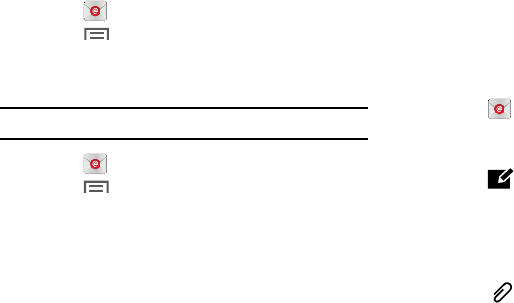
Messaging 57
Deleting Email Accounts
To delete an Email account:
1. Touch
Email
.
2. Touch
Menu
➔
Settings
➔
Delete account
.
Email Settings
Use the Email Settings to configure your Email preferences.
Note:
Available settings depend on the email provider.
1. Touch
Email
.
2. Touch
Menu
➔
Settings
, then touch
General settings
. The following options display:
•Display
: Set how email is shown in the email list and when you
open them.
• Composing and sending
: Set what functions are available
while composing and sending email.
• Auto-advance
: Set the screen to show after deleting a
message. Choices are: Next email, Previous email, or Email list.
• Confirm deletions
: Ask for confirmation before deleting email.
•Priority senders
: Enter email addresses that you want treated
as a priority.
• Spam addresses
: Manage your spam address list.
• Rules for filtering
: Create rules for filtering email based on
names, address, or subject.
3. Touch an account to configure specific settings.
Available options depend on the account.
Composing and Sending Email
1. Touch
Email
.
2. If you have multiple accounts set up, choose an
account from the menu at the top of the screen.
3. Touch
Compose
, then touch fields to enter
recipients and the email text.
4. While composing a message:
•
Touch displayed buttons to set Priority, Tracking options,
Security options, and so on.
•
Touch
Attach
to add a file to the message.
Available options depend on the type of email account.
5. Touch the body of the email to enter the text of your
email. Touch the text option buttons to edit and format
your message text.
DRAFT For Internal Use Only
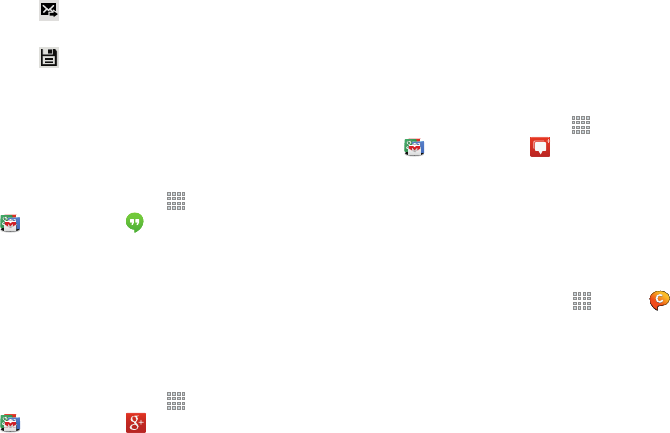
58
6. Touch
Send
to send the message.
– or –
Touch
Save
to save the email to the Drafts folder.
Hangouts
Previously known as Google Talk, Hangouts is an online place
to meet friends and family, share photos, and host video
calls. Conversation logs are automatically saved to a Chats
area in your Gmail account.
䡲
From a Home screen, touch
Apps
➔
Google
folder ➔
Hangouts
.
Google+
Google+ makes messaging and sharing with your friends a
lot easier. You can set up Circles of friends, visit the Stream
to get updates from your Circles, use Messenger for fast
messaging with everyone in your Circles, or use Instant
Upload to automatically upload videos and photos to your
own private album on Google+.
䡲
From a Home screen, touch
Apps
➔
Google
folder ➔
Google+
.
Messenger
With Google Messenger, you can bring groups of friends
together into a simple group conversation, putting everyone
on the same page. When you get a new conversation in
Messenger, Google+ sends an update to your device.
䡲
From a Home screen, touch
Apps
➔
Google
folder ➔
Messenger
.
ChatON
A smart-messaging app that gives you a host of innovative
ways to stay connected with all your friends and family,
regardless of their device or platform. Use ChatON to send
and receive instant messages from any device that has a
mobile phone number.
1. From a Home screen, touch
Apps
➔
ChatON
.
If you are launching this application for the first time,
follow the on-screen instructions to complete the
account setup.
2. Enter and send your message.
DRAFT For Internal Use Only
Messaging 59
DRAFT For Internal Use Only
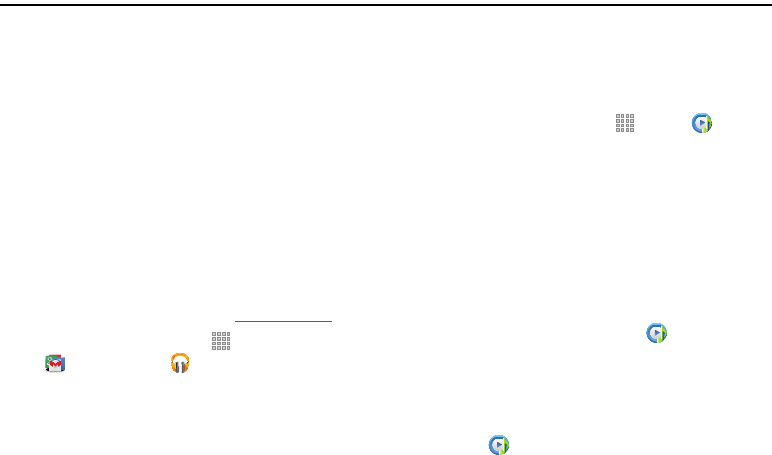
60
Section 5: Music
Listening to Music
You can listen to music by using your device’s built-in
speakers, through a wired headset, or through a wireless
Bluetooth stereo headset.
For more information, refer to “Bluetooth” on page 87.
Press the
Volume Key
on the side of the device to activate on-
screen volume control, then touch and drag on the scale to
set volume. You can also press the Volume Key to adjust
playback volume.
Play Music
Google Play Music is a Google service that gives you instant
access to your personal music collection on the Internet and
your compatible Android devices without the hassle of wires
or syncing. For more information, visit
music.google.com
.
䡲
From a Home screen, touch
Apps
➔
Google
folder ➔
Play Music
.
Music Player
Music Player plays songs stored on your tablet or an installed
memory card.
To access Music Player:
1. From a Home screen, touch
Apps
➔
Music
.
The Music Player application searches your device’s
internal storage or on an installed memory card for
music and playlists. This can take from a few seconds
to several minutes, depending on the amount of new
music added since you last opened the application. It
then displays your music in several ways.
2. Touch a tab, such as
Songs
,
Playlists
,
Albums
, and so
on, to change the way you view the contents of your
library.
3. Touch the Music application icon at the top-left of
the Application bar to return to the previous Music
screen.
Searching for Music
To find music in your library:
1. Touch
Music
.
DRAFT For Internal Use Only

Music 61
2. Touch
Search
and use the keyboard to type the
name of an artist, album, or song.
Music Player Options and Settings
To use Music Player options and configure settings:
1. Touch
Music
.
2. Touch
Menu
to display the following options:
• List view / Thumbnail view
: View your music in a list or
thumbnail format.
•Delete
: Delete a song, an album, or every song or album.
• Scan for nearby devices
: Discover and connect directly to
nearby devices.
•Settings
: The following settings display:
–
SoundAlive
: Configure SoundAlive.
–
Adapt Sound
: Enhance sound quality.
–
Play speed
: Decrease or increase play speed.
–
Smart volume
: Automatically adjust volume to surroundings.
–
Voice control
: Use voice commands to control playback.
–
Lyrics
: Display the lyrics of the song, if available.
–
Music auto off
: Set the option Off or set your music to turn off
automatically by touching one of the time values.
•End
: Close the Music Player app.
Managing Playlists
To create, manage, or delete a playlist:
䡲
Touch
Music
.
Creating a Playlist
䡲
Touch
Create playlist
and use the keyboard to
enter a name for the playlist.
Renaming a Playlist
1. Touch the
Playlists
tab.
2. Touch a playlist, touch
Menu
➔
Edit title
and use
the keyboard to enter a new name for the playlist.
DRAFT For Internal Use Only
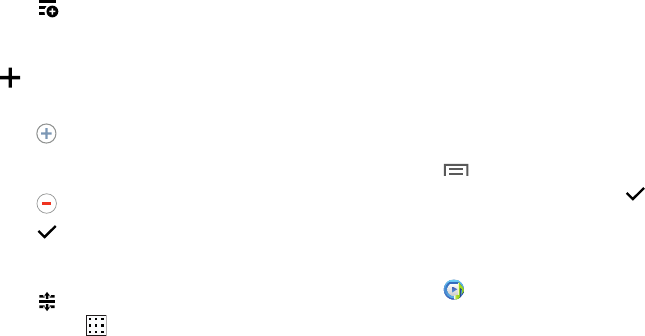
62
Adding Songs to or Removing Songs from Playlists
1. Touch
Create playlist
and touch a playlist.
– or –
Touch
Playlists
, touch a playlist, and then touch
Add music
.
All songs are displayed.
2. Touch
next to each song you want to add or next to
Add all
to add all songs to the playlist.
– or –
Touch
to remove a song from the playlist.
3. Touch
Done
to save the playlist.
Changing the Order of a Playlist
1. Touch the
Playlists
tab and touch a playlist.
2. Touch
Change order
.
3. Touch the grid for an entry and drag the entry to a
new position in the list.
4. Touch
Done
to change the order and save the playlist.
Playing a Playlist
1. Touch the
Playlists
tab.
2. Touch
Favorites
,
Most played
,
Recently played
, or
Recently added
, or touch a playlist title that you
created.
3. Touch a song to start playing the playlist at that song.
Deleting a Playlist
1. Touch the
Playlists
tab and touch a playlist.
2. Touch
Menu
➔
Remove
.
3. Touch the box next to
Select all
, touch
Remove
, and
then touch
OK
.
Playing Music
To play a song:
1. Touch
Music
.
2. Touch a song or touch an album or genre and then
touch a song in the list of songs on the album.
The song you touch starts to play. The tracks in the
current list play in order until you reach the end of the
list (unless you choose a repeat option). Otherwise,
playback stops only if you stop it, even when you
switch applications.
DRAFT For Internal Use Only
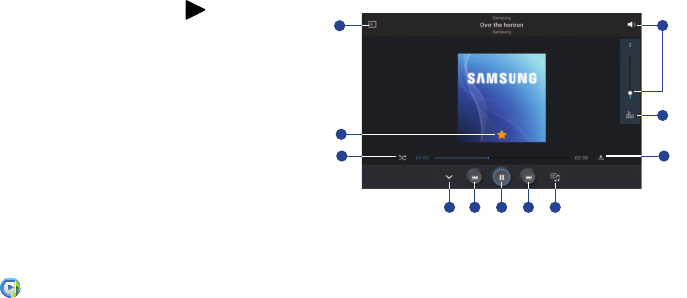
Music 63
Accessing the Music Player
If you navigate away from the Music Player application and
music is playing, the Music notification icon is displayed
in the System Bar.
You can change songs or easily return to the Music Player:
1. Touch the top of the screen and swipe downward.
The Notification Panel displays.
2. Touch the song thumbnail to display the Music Player.
You can also pause and resume playback and skip to
the next or previous song in the panel. For more
information, refer to “Notifications” on page 35.
Music Player Controls
When a song is playing, the Music Player screen displays
and
various controls are available.
1. Touch
Music
.
2. Touch a song or playlist to begin playback.
The music player displays below (portrait mode) or to
the right (landscape mode) of the music listing.
3. Touch the song thumbnail to enlarge the music player.
Music Player Controls
During playback, use the sound and playlist controls:
1. Scan DLNA-enabled devices.
2. Touch to display the volume control, then touch and
drag on the scale to set volume. You can also press the
Volume Key on the side of the device to adjust playback
volume.
12
4
5
7 8 9 10 11
6
3
DRAFT For Internal Use Only

64
3. Touch to view and set SoundAlive options.
4. Set the file as your favorite song.
5. Turn on shuffle.
6. Change the repeat mode.
7. Hide the music player screen.
8. Restart the currently-playing song or skip to the
previous song. Touch and hold to move backwards
quickly.
9. Pause and resume playback.
10. Skip to the next song. Tap and hold to move forwards
quickly.
11. Open the playlist.
Options While Playing a Song
There are various options and controls available while a song
is playing:
1. Touch
Music
, touch a song or an album, and then
a song.
2. Touch the music player to enlarge it.
3. Touch
Menu
to display the following options:
• Add to playlist
: Add the song to a new playlist or an existing
playlist.
• Via Bluetooth
: Play the current song by using a Bluetooth
device.
• Play via Group Play
: Share the current song by using
Group Play.
• Scan for nearby devices
: Discover and connect directly to
nearby devices.
DRAFT For Internal Use Only

Music 65
•Details
: View song details.
• Set as alarm tone
: Use the current song as an alarm tone.
•Settings
: Displays Music Player settings. For more information,
refer to
“Music Player Options and Settings”
on
page 61.
•End
: This option returns you to the home screen.
Playing Music by Mood
Play music grouped by mood. The playlist is automatically
created by the device. When a new song is added:
1. Touch
Music
➔
Music square
➔
Library update
.
2. Touch
Music square
and select a cell of mood. Or select
multiple cells by dragging your finger.
•
DRAFT For Internal Use Only
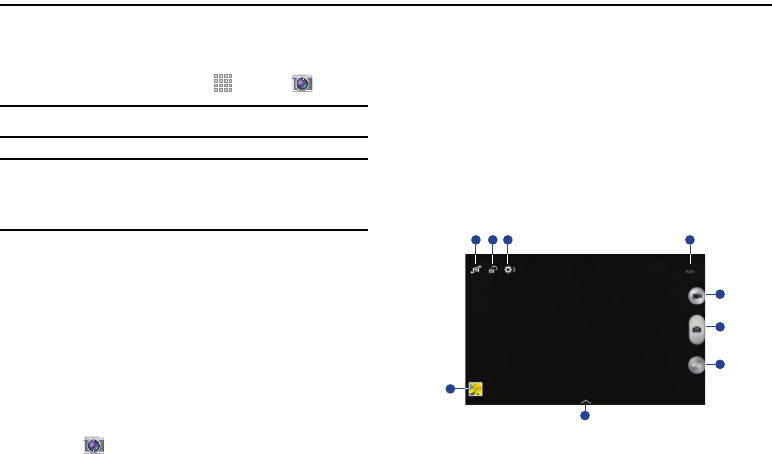
66
Section 6: Camera and Video
Camera
Use this application to take photos or videos.
䡲
From a Home screen, touch
Apps
➔
Camera
.
Note:
The camera automatically shuts off when unused.
Note:
Make sure that the lens is clean. Otherwise, the device
may not work properly in some modes that require high
resolutions.
Camera Etiquette
•
Do not take photos or videos of other people without their
permission.
•
Do not take photos or videos where legally prohibited.
•
Do not take photos or videos in places where you may violate
other people’s privacy.
Using the Camera
To access the Camera:
1. Touch
Camera
.
If a memory card is inserted, the Storage location
pop-up displays.
2. Touch
OK
to change the storage location to
memory card.
– or –
Touch
Cancel
to use the device storage for storing
pictures and videos.
The Camera screen displays.
1. Switch between the front and rear camera.
1
6
7
5
34
2
8
9
DRAFT For Internal Use Only

Camera and Video 67
2. Switch to dual camera mode.
3. View more options.
4. Display current mode.
5. Record video button.
6. Camera button.
7. Shooting mode.
8. Open Gallery to view photos and videos.
9. Select an available effect.
Taking Photos
1. Touch the image on the preview screen where the
camera should focus.
When the subject is in focus, the focus frame turns
green.
2. Touch to take the photo.
Shooting Mode
Several photo effects are available.
䡲
Touch
MODE
, and then scroll up or down the screen at
the right side of the screen.
•Auto
: Use this to allow the camera to evaluate the surroundings
and determine the ideal mode for the photo.
• Beauty face
: Take a photo with lightened faces for gentler
images.
•Best photo
: Take a series of photos, and then save the
best one.
DRAFT For Internal Use Only
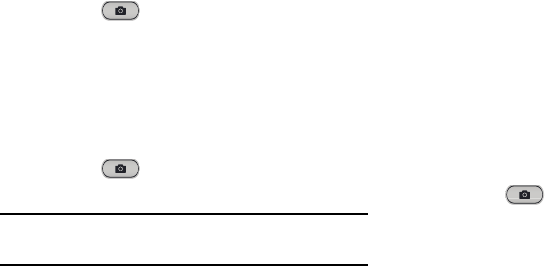
68
• Best face
: Use this to take multiple group shots at the same
time and combine them to create the best possible image.
–
Touch to take multiple photos. To get the best shot,
hold the camera steady and remain still while taking photos.
When
Gallery
opens, touch the yellow frame on each face, and
choose the best individual pose for the subject. After choosing a
pose for each individual, touch
Save
to merge the images into a
single photo, and save it.
• Sound & shot
: Use this to take a photo with sound.
–
Touch to take a photo. The device records a few
seconds of audio after taking a photo.
Note:
While taking photos in this mode, sound is recorded by
the internal microphone.
•Drama
: Use this to take a series of photos and combine them
to create an image that shows trails of the movement.
To get the best shot, follow these tips. The device may not take
photos properly in other shooting conditions.
–
Hold the camera steady and remain still while taking photos.
–
Take photos of a subject that is moving in one direction.
–
Take photos with backgrounds that are free of moving objects.
–
Avoid taking photos of a subject and background with similar
colors.
–
Avoid taking photos of a subject that is too close or too far away
to fit within the viewfinder or that is too long such as a bus or a
train.
• Rich tone (HDR)
: Use this to take photos without losing details
in bright and dark areas.
•Eraser
: Use this to erase the movements of moving subjects in
the background.
–
Touch to take a series of photos. The device erases
traces of movement from a moving subject. To restore the
original photo, touch Show moving objects, and then touch the
highlighted area.
To get the best shot, follow these tips:
–
Hold the camera steady and remain still while taking photos.
–
Avoid taking photos of a subject and background with similar
colors.
DRAFT For Internal Use Only
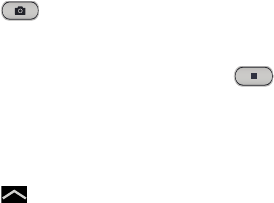
Camera and Video 69
–
When taking photos of a subject that is moving very little or
moving a great deal, the camera may not recognise all of the
movements.
–
If there are multiple subjects moving in the background, the
camera may not recognise all of the movement.
•Panorama
: Take a photo composed of many photos strung
together.
To get the best shot, follow these tips:
–
Move the camera slowly in one direction.
–
Keep the camera’s viewfinder within the guide frame.
–
Avoid taking photos of a subject in front of unrecognizable
backgrounds, such as empty skies or plain walls.
•Sports
: Use this setting for fast-moving subjects.
•Night
: Use this setting for images taken in darker conditions.
Panoramic Photos
A panoramic photo is a wide landscape image consisting of
multiple shots.
1. Touch
MODE
➔
Panorama
.
2. Touch and move the camera in one direction.
When the blue frame aligns with the viewfinder, the
camera automatically takes another shot in a
panoramic sequence. To stop shooting, touch .
If the viewfinder is out of the direction, the device stops
shooting.
Applying Filter Effects
Use the filter effects to take unique photos or videos.
䡲
Touch and select a filter effect. The available
options vary by mode.
DRAFT For Internal Use Only
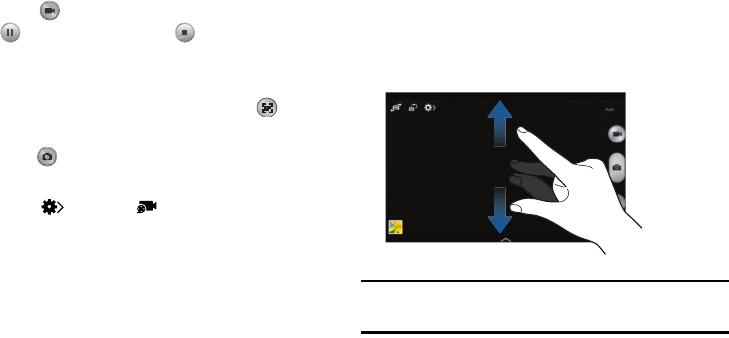
70
Recording Videos
To record a video:
䡲
Touch to take a video. To pause recording, touch
. To stop recording, touch .
While recording, use the following actions:
䡲
To change the focus, touch where you want to focus.
To focus on the centre of the screen, touch .
䡲
To capture an image from the video while recording,
touch .
Recording Mode
䡲
Touch
Options
➔
Recording mode
to change
the recording mode.
•Normal
: Use this mode for normal quality.
• Limit for email
: Use this mode to lower quality for sending via
messages.
• Fast motion
: Use this mode when recording action scenes.
Zooming In and Out
Use one of the following methods:
䡲
Use the
Volume
button to zoom in or out.
䡲
Spread two fingers apart on the screen to zoom in, and
pinch to zoom out.
Note:
The zoom in and out effect is available when using the
zoom feature while shooting video.
DRAFT For Internal Use Only
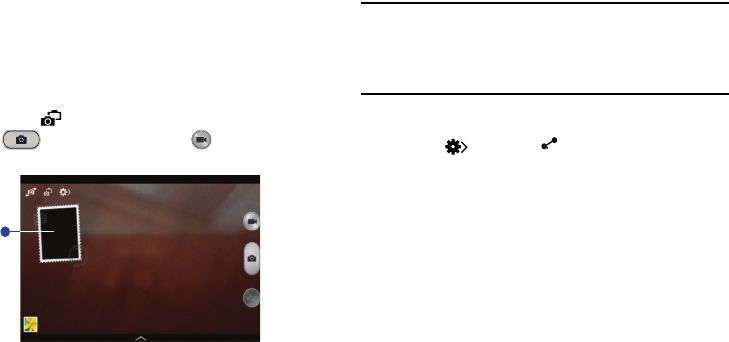
Camera and Video 71
Dual Camera Mode
When you take a landscape photo with the rear camera, the
photo or video captured by the front camera appears in an
inset window, or vice versa. Use this feature to take a
beautiful landscape photo and a self-portrait simultaneously.
䡲
Touch to switch to dual camera mode. Touch
to take a photo or touch to take a video.
1. Tap to resize it or move the location.
Note:
You can record videos in dual camera mode for up to 5
minutes in Full HD and up to 10 minutes in HD. While
taking videos in this mode, sound is recorded by the
internal microphone.
Share Shot
䡲
Touch
Options
➔ , and then select one of the
following:
•Share shot
: Send a photo directly to another device via Wi-Fi
Direct.
• Buddy photo share
: Set the device to recognise a person’s
face that you have tagged in a photo and send it to that person.
• ChatON photo share
: Send a photo to another device via
ChatON.
• Remote viewfinder
: Set a device to control the camera
remotely.
1
OFF
DRAFT For Internal Use Only
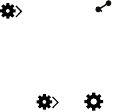
72
Controlling the Camera Remotely
Set a device as a viewfinder to control the camera remotely.
Touch
Options
➔ ➔
Remote viewfinder
, and then
connect the device and the camera using Wi-Fi Direct. Touch
to take a photo remotely using the device as a viewfinder.
Configuring Settings for Camera
䡲
Touch ➔ to configure settings for Camera.
Not all of the following options are available in both still
camera and video camera modes. The available
options vary depending on the mode used.
• Photo size/ Video size
: Select a resolution. Use higher
resolution for higher quality. But it takes up more memory.
• Burst shot
: Take a series of photos of moving subjects.
• Tap to take pics
: Touch the image on the preview screen to
take photos.
• Face detection
: Set the device to recognise people’s faces and
help you take photos of them.
• Metering
: Select a metering method. This determines how
light values are calculated. Centre-weighted measures
background light in the centre of the scene. Spot measures
the light value at a specific location. Matrix averages the
entire scene.
•ISO
: Select an ISO value. This controls camera light sensitivity.
It is measured in film-camera equivalents. Low values are for
stationary or brightly-lit objects. Higher values are for fast-
moving or poorly-lit objects.
• Video stabilization
: Activate or deactivate anti-shake. Anti-
shake helps focus when the camera is moving.
• Auto night detection
: Set the device to automatically detect
darker conditions and adjust the brightness of the photo
without the flash.
• Save as
: Set the device to delete the original photo when
taking photos with rich tone mode.
OFF
DRAFT For Internal Use Only

Camera and Video 73
•Location tag
: Attach a GPS location tag to the photo.
Note:
To improve GPS signals, avoid shooting in locations
where the signal may be obstructed, such as between
buildings or in low-lying areas, or in poor weather
conditions.
•Review
: Briefly display photos taken.
•Volume key
: Set the device to use the Volume button to control
the shutter or zoom function.
•Timer
: Use this for delayed-time shots.
• White balance
: Select an appropriate white balance, so
images have a true-to-life color range. The settings are
designed for specific lighting situations. These settings are
similar to the heat range for white-balance exposure in
professional cameras.
•Exposure value
: Change the exposure value. This determines
how much light the camera’s sensor receives. For low light
situations, use a higher exposure.
• Guidelines
: Display viewfinder guides to help composition
when selecting subjects.
•Flash
: Activate or deactivate the flash.
• Voice control
: Set the camera to take photos with voice
commands.
• Contextual filename
: Set the camera to display contextual
tags. Activate this to use Tag Buddy in Gallery and Story Album.
• Save as flipped
: Invert the image to create a mirror-image of
the original scene.
•Storage
: Select the memory location for storage.
• Reset
: Reset the camera settings.
DRAFT For Internal Use Only
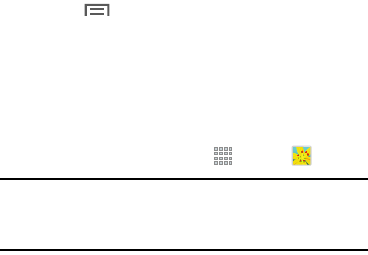
74
Shortcuts
Reorganize shortcuts for easy access to the camera’s various
options.
1. Touch
Menu
➔
Edit
quick settings
.
2. Touch and hold an option and drag it to a slot at the top
of the screen. The other icons can be moved within the
list by touching and dragging them.
Gallery
Use this application to view images and videos.
䡲
From a Home screen, touch
Apps
➔
Gallery
.
Note:
Some file formats are not supported depending on the
software installed on the device. Some files may not
play properly depending on the encoding method used.
Viewing Images
Launching Gallery displays images by creation date.
䡲
To sort images by location, people, or other categories,
touch
Time
and select a category. Albums displays
images by folder.
䡲
In a folder, images are displayed by creation date.
Select an image to view it in full screen.
䡲
Scroll left or right to view the next or previous image.
Zooming In and Out
Use one of the following methods to zoom in an image:
䡲
Double-touch anywhere to zoom in.
䡲
Spread two fingers apart on any place to zoom in.
Pinch to zoom out, or double-tap to return.
DRAFT For Internal Use Only
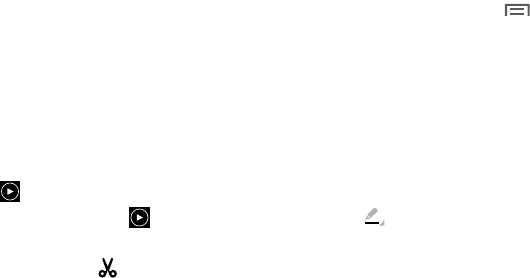
Camera and Video 75
Viewing Images Using the Motion Feature
Use the motion feature to execute a function with particular
motion.
1. On the Applications screen, touch
Settings
➔
Controls
tab
➔
Motions
, drag the
Motions
switch to the
right, and then turn on the switch for each feature.
2. To stop using a motion feature, drag the
Motions
switch
to the left.
Playing Videos
Video files show the icon on the preview.
䡲
Select a video to watch it and touch .
Trimming Segments of a Video
1. Select a video, and then touch .
2. Move the start bracket to the desired starting point,
move the end bracket to the desired ending point, and
then save the video.
Editing Images
䡲
When viewing an image, touch
Menu
and use the
following functions:
•Edit
: Use Photo Editor to edit your photo.
•Favorite
: Add to the favorites list.
•Slideshow
: Start a slideshow with the images in the current
folder.
•Photo frame
: Use this to add a frame and a note to an image.
The edited image is saved in the Photo frame folder.
•Photo note
: Use this to write a note on the back of the image.
Touch to edit the note.
•Copy to clipboard
: Copy to clipboard.
•Print
: Print the image via a USB or Wi-Fi connection. Some
printers may not be compatible with the device.
•Rename
: Rename the file.
DRAFT For Internal Use Only

76
• Buddy photo share
: Send the image to a person whose face is
tagged in the image.
•Rotate left
: Rotate counter-clockwise.
• Rotate right
: Rotate clockwise.
•Crop
: Resize the blue frame to crop and save the image in it.
•Set as
: Set the image as wallpaper or a contact image.
•Details
: View image details.
• Settings
: Change the Gallery settings.
Modifying Images
䡲
When viewing an image, touch
Menu
➔
Edit
and
use the following functions:
•Rotate
: Rotate the image.
•Crop
: Crop the image.
• Color
: Adjust the saturation or brightness of the image.
• Effect
: Apply effects to the image.
• Sticker
: Attach stickers.
•Drawing
: Draw on the image.
•Frame
: Apply frames to the image.
Favorite Images
䡲
When viewing an image, touch
Menu
➔
Favorite
to add the image to the favorites list.
Deleting Images
Use one of the following methods:
䡲
In a folder, touch
Menu
➔
Select item
, select
images by ticking, and then touch
Delete
.
䡲
When viewing an image, touch
Delete
.
Sharing Images
Use one of the following methods:
䡲
In a folder, touch
Menu
➔
Select item
, select
images by ticking, and then touch to send them to
others or share them via social network services.
䡲
When viewing an image, touch to send it to others
or share it via social network services.
DRAFT For Internal Use Only

Camera and Video 77
Setting as Wallpaper
䡲
When viewing an image, touch
Menu
➔
Set as
to
set the image as wallpaper or to assign it to a contact.
Tagging Faces
1. Touch
Menu
➔
Settings
➔
Tags
➔
Face tag
. A
yellow frame appears around the recognized face.
2. Touch the face, touch
Add name
, and then select or add
a contact.
3. When the face tag appears on an image, touch the face
tag and use available options, such as sending
messages.
Note:
Face recognition may fail depending on the face angle,
face size, skin color, facial expression, light conditions,
or accessories the subject is wearing.
Using Tag Buddy
䡲
Touch
Menu
➔
Settings
➔
Tags
➔
Tag buddy
,
and then drag the Tag buddy switch to the right to
display a contextual tag (weather, location, date, and
person’s name) when opening an image.
DRAFT For Internal Use Only
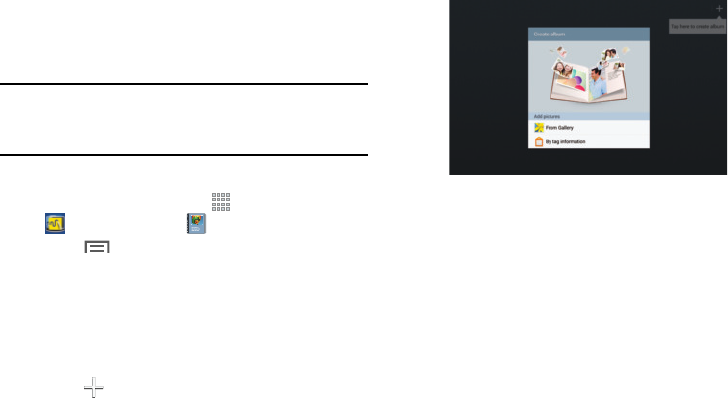
78
Story Album
Use this application to create your own digital album to keep
your stories by organizing the images neatly and
automatically.
Note:
The Story Album app must be installed before you can
use it. Touch OK on the pop-up and follow the on-screen
instructions.
To access Story Album:
1. From a Home screen, touch
Apps
➔
Samsung
folder ➔
Story Album
.
2. Touch
Menu
➔
Help
to learn more about
Story Album.
Creating Story Albums
Create story albums by selecting images from Gallery or
images sorted by tag information.
To create a story album manually:
1. Touch Create album.
The Create album screen displays.
2. Touch From Gallery to add pictures from the Gallery.
– or –
Touch By tag information to create the story album
automatically. Select criteria, and then touch Find
pictures. Enter a title for the album, select a theme,
and then touch Create album.
DRAFT For Internal Use Only

Camera and Video 79
Creating Recommended Albums
When you take photos at one location, the device
automatically sorts your photos into albums based on your
specified criteria and suggests making the new albums.
䡲
Touch
Menu
➔ Settings ➔ Home city, and then
set a method for recognizing your location. Select an
album type and set a minimum number of photos.
Viewing Story Albums
1. Select a story album. The cover image appears on the
first page. Scroll left or right to view images in the
story album.
2. On a page of the album, touch
Menu
and use the
following functions. The available options vary
depending on the page.
• Edit title
: Rename the album.
• Change theme
: Change the theme for the album.
• Change cover image
: Change the cover image of the album.
•Slideshow
: Start a slideshow with the images in the
current album.
•Share via
: Send the album to others.
•Print
: Print the album via a USB or Wi-Fi connection. Some
printers may not be compatible with the device.
• Order photo book
: Place an order for a printed album.
•Export Album
: Export the album to other storage locations.
• Add content
: Add more content to the current page.
• Remove content
: Delete content on the current page.
•Edit
: Change the layout of the current page.
• Delete page
: Delete the current page.
Managing Story Albums
1. Touch and hold a story album.
2. Touch one or more story albums or touch the
selected
tab ➔
Select all
.
3. Touch
Share via
to create a PDF file or a Story
Album file (.scc).
4. Touch
Delete
to delete the selected story albums.
# selected
DRAFT For Internal Use Only

80
Editing Images
1. Touch the image of the page in an album.
The following options are available:
2. Touch
Menu
, and then use the following
functions:
•Slideshow
: Start a slideshow or change the slideshow
settings.
• Set as cover
: Set the image as an album cover image.
•Rotate left
: Rotate the image counter-clockwise.
• Rotate right
: Rotate the image clockwise.
Video
Use this application to play video files.
䡲
From a Home screen, touch
Apps
➔
Video
.
Note:
Some file formats are not supported depending on the
device's software.
Add a caption.
Send the image to others.
Delete the image.
Select among various effects that are
available.
DRAFT For Internal Use Only